
We provide comprehensive cleaning and sanitising solutions tailored to your exacting needs. From products and equipment, to auditing and staff training, we ensure the perfect solution for you, every time. Contact us at awsgroup.co.nz Tailored








We provide comprehensive cleaning and sanitising solutions tailored to your exacting needs. From products and equipment, to auditing and staff training, we ensure the perfect solution for you, every time. Contact us at awsgroup.co.nz Tailored






It was extremely encouraging to hear our PM saying recently he wants to remove red tape preventing
large-scale
water storage projects being built nationally which were “absolutely critical to ensuring land was productive” and his coalition government were united on their importance.
This is fantastic and wow what a change in government direction within that statement for such a critical part of being able to farm and grow, including the confidence to invest. To me it seems the policy supporting water storage has really struggled since the Crown devolved irrigation schemes to industry in the late 1980s, and more recently when Crown irrigation investments reduced. And while this was happening freshwater reforms were introduced, giving the strong signal that storage and irrigation were non-essential for New Zealand, and unfortunately even more so they gave the impression that medium and largescale water storage was detrimental…!
JUST OVER 5% OF OUR FARMLAND AND ORCHARDS... IS IRRIGATED AND OF THIS THE MAJORITY IS IN PASTORAL USE
This all resulted is multiple government agencies, including the Ministry for the Environment, taking a greater role in policy setting, which historically had been driven more by the Ministry of Agriculture & Forestry which became the Ministry for Primary Industries. This in turn then led to regional councils being uncertain about the national policy direction, and as a result very conservative with their interpretations of what they need to be doing.
With multiple government agencies working with a lack of clear government strategy, there has been a lack of coordination and vision, leading to little development of sizeable capture and storage schemes for productive use, for the country’s resilience to climate change, and for potential land use change to better economic and environmentally friendly options, such as for horticulture. A frustrating situation of the left hand not knowing what the right was doing, and hence the Waimea Dam taking over 15 years to get resource consent, and other dams like Ruataniwha being shelved, and this proposal would have died apart from a small very committed group continuing the fight.
Freshwater accounts for only three percent of the water on the planet, and two-thirds of that is inaccessible either frozen in glaciers or hidden under the earth’s surface, so we only have access to around one percent.

In most regions of the world, over 70 percent of freshwater is used for agriculture. And by 2050, feeding a planet of nine billion people will require an estimated 50 percent increase in agricultural production and at least a 15 percent increase in water used for this production.
Many regions and countries have historically had to live with water scarcity, such as Africa and the Middle East, but now surprisingly, new countries have been added to the list including the United States, Spain and Italy, along with others which are all really struggling with insufficient water for agriculture. Science tells us that due to the impact of climate change we will have more prolonged drought periods, along with more intense rainfall events globally.
Compared to others in the world, New Zealand as a country is blessed with freshwater. It has been and still can be one of our most significant competitive advantages, but due to the lack of government leadership and support, since the 1980s we have dropped the ball big time and not realised the huge opportunities we have in front of our noses.
Our freshwater arrives in rain events where nearly all of it runs out into the sea or it evaporates – a lost opportunity. Just over five percent
of our farmland and orchards, or just under one million hectares of land, is irrigated and of this the majority is in pastoral use. Canterbury stands out with 60 percent of its farm area irrigated, just over half of the New Zealand total. Not surprisingly, the regions with the least irrigation are on the West Coast where plentiful and regular rainfall has historically occurred, while the most highly irrigated regions are on the East Coast, such as Hawke’s Bay and Wairarapa, along with Canterbury.
The current poor state of water storage has left the country vulnerable to droughts and floods, and equally importantly has led to significant missed opportunities for investment in diversification of land use, which includes growth in horticulture to realise greater value of land use with a lower environmental footprint. I often compare Kerikeri with Kaikohe, one had an irrigation scheme built in the 1980s and has prospered, the other didn’t, and has really struggled socially and economically; but the good news thankfully is that Te Tai Tokerau is developing water storage for that area now.
So what needs to be done? – Lots, and this government is signalling the right things; and getting the policy settings right for water storage is one of Horticulture New Zealand’s priority areas of focus.
Water storage can be small, medium and large. While there is a place for all, the reality is only large-scale water storage schemes provide for the really significant economic benefits across a region and its communities, so the government getting serious about supporting large water schemes is a good start.
Consenting for big infrastructure schemes absolutely needs central government direction and assistance, or they are likely to get kicked around for an eternity and the life force sucked out of the proponents.
The government’s fast-track infrastructure consenting bill is therefore a very welcome development.
Done right, water storage schemes have a positive environmental effect as they can provide water to the river when flows are low, and also capture water to restrict the impacts of flood events. The Opuha Dam in South Canterbury is a great example of this, as will the Waimea Dam be as well.
HortNZ is proactively involved in influencing government and regional policy to allow for sensible water storage schemes
The proponents of large-scale water schemes cannot devolve their responsibilities for how they take the community, including Māori, with them as they develop their proposals, and will need to work to achieve support. At times they will need to work in partnerships so that they come up with a proposal that has the critical local community and public backing.
HortNZ is proactively involved in influencing government and regional policy to allow for sensible water storage schemes, and working with others such as Irrigation NZ to see this happen. Water storage is one of our three key priorities, so I hope this month’s magazine will result in a robust conversation as to the need and benefits.
If we can get water storage working right, we also won’t have to have such a stoush with water allocation, which when we look at all the competing parties involved can only end up ugly! To me the only solution for us as a country is water storage, storage, storage, and then even more storage!
Kia kahaEditors:
Acting Editor:
John Gauldie
Email: editor@hortnz.co.nz
Advertising Manager:
Debbie Pascoe
Ph: 027 485 8562
Email: debbie.pascoe@hortnz.co.nz
Design:
Scenario Communications
Ph: 04 385 9766
Email: joy@scenario.co.nz
Subscriptions:
Email: info@hortnz.co.nz
NZGrower is produced by Horticulture New Zealand and is free for all levy payers.
The magazine is also supported by: Vegetables NZ, Process Vegetables NZ, TomatoesNZ, Potatoes NZ and Onions NZ
The individual comments and views in this magazine do not necessarily represent the view of Horticulture New Zealand.
ISSN: 2230-2700 (Print)
ISSN: 2744-5712 (Online)
This publication uses vegetable based inks and environmentally responsible paper produced from Forest Stewardship Council® (FSC®) certified, Mixed Source pulp from Responsible Sources.
Paper produced using Elemental Chlorine Free (ECF) and manufactured under the strict ISO14001 Environmental Management System.
The wrapper we use is 100% recyclable, it is LDPE 4 (Low Density Polyethylene) Soft Plastic and meets the required standards. For further information refer to: https://www.recycling.kiwi. nz/our-story


Horticulture New Zealand has now finished its grower meetings across the country and we’ve had some great discussions about a range of issues affecting the sector.
At these meetings we have been outlining HortNZ’s three policy priorities to support growers: climate change and adaptation; water allocation and storage; food security and supply.
Water allocation and storage has certainly been a hot topic of conversation for growers.
Growers are dealing with the implications of the El Niño weather pattern now prevailing over New Zealand, which means drier conditions for many regions.
This is why ensuring water resilience through availability and storage is a key priority in the Aotearoa Horticulture Action Plan (AHAP) and why we need policies to support the expansion of, and investment in, water storage. This focus area in AHAP calls for strategic, evidence-based co-investment in regional water storage for climate change adaptation.
We know horticulture is a very efficient user of water but needs a higher degree of reliability than other land uses.
Unfortunately, when a first-in-first-served approach is used to allocate the volume of water allowed to be taken from rivers, and an ecosystem health approach is used to set the minimum flow, horticulture gets caught with the most significant impacts due to the importance of water reliability for fruit and vegetable quality.
In our discussions with the new government, we have been clear that investment in land and water is critical if we are to maintain a thriving horticulture sector.
We cannot grow without the use of New Zealand’s highly productive land. We cannot grow without access to water.
Current policy settings and attitudes – particularly in the areas of land and water use – do not support horticulture’s growth so it has been encouraging to see the new government’s commitment to exploring water storage solutions.
Water allocation and storage has certainly been a hot topic of conversation for growers
In addition to prioritising water allocation and developing policy settings that support the expansion of and investment in water storage, we also need to ensure that water consent timeframes give growers the certainty to invest and increase production, while improving environmental outcomes.
That’s why we will be continuing to push the case for growers with government in the freshwater settings space.
Over the past few weeks, I have heard the message loud and clear.
Growers want reliable access to water and discharges and policy settings and investment that enable water storage so horticulture can expand in a way that supports freshwater health.
In May and June, growers will get the chance to have their say on the future of HortNZ when voting opens in our referendum.
Without grower support in this levy referendum, HortNZ will be wound up so it’s really important growers engage and have their say on what you want from your levy organisation.
Your support for HortNZ enables us to help you to make more informed decisions for your business, provides you with certainty to invest, gives you tools, resources and services to lift your productivity and profitability, and ensures your voice is heard at all levels.
We advocate on your behalf for sound and sensible policy settings such as in the freshwater space that allow you to get on with business and thrive.
Look out for more information on the referendum which will be coming to all growers soon. Your levy working for
It is critical that regulators can recognise industry assurance programmes to deliver freshwater objectives.
Horticulture New Zealand successfully advocated for a pathway in law to enable recognition of GAP (Good Agricultural Practice) to audit and certify freshwater farm plans. The detailed pathway is now being designed. Meanwhile, growers continue to demonstrate credible environmental practice using GAP, across more than half of New Zealand’s horticultural land.
Freshwater farm plan requirements are embedded in law (Part 9A of the Resource Management Act). The law is enacted through the Resource Management (Freshwater Farm Plans) Regulations 2023. These regulations have already been turned on in some regions of New Zealand. The new government has signalled the need for these regulations to be more workable and effective. The process for this has not been mapped out yet.
Horticulture is well placed through the GAP schemes to respond to new and changing market and regulatory requirements. GLOBALG.A.P. and NZGAP have been providing assurance that horticultural businesses are producing safe and sustainable produce for 25 years. Growers choose and trust GAP because it is an efficient and effective way to meet food safety, environmental and social practice standards. Stakeholders trust GAP certification because of the integrity and accountability of the system.
GAP standards are integrated and benchmarked against external requirements. Instead of growers interacting with each market and regulator separately, growers choose GAP’s integrated farm planning and assurance framework to demonstrate they meet all requirements applicable to their business, whether they supply the domestic market or export overseas.
GAP standards are risk-based and outcomes-focused. Schemes can remain agile and adaptable as requirements change. Standards are regularly updated to offer highquality and fit-for-purpose farm assurance solutions.
It is critical that markets and regulators recognise the importance of GAP schemes and their ability to deliver outcomes effectively and efficiently.
Markets and regulators need a pathway to assess and recognise schemes as equivalent to their requirements.
Since the whole GAP system delivers an integrated solution for growers, it is important that the whole system is recognised, not just some parts. In other words, it’s not just about what a grower does on their operation, but also about the audit and certification process, administration and reporting, and the overall operation of the scheme that ensures the integrity behind the standard is upheld.
Since the whole GAP system delivers an integrated solution for growers, it is important that the whole system is recognised, not just some parts
HortNZ has advocated very strongly for a process to recognise industry GAP schemes. Our advocacy resulted in Ministerial intervention. Now, there is a pathway to recognise industry schemes to audit and certify freshwater farm plans in the Resource Management Act (RMA) through an amendment passed in 2023.
“This is a significant step in the right direction,” says Michelle Sands, HortNZ general manager strategy and policy.
The exact process for recognition is not yet clear. The horticulture industry is participating in a stakeholder group supporting the Ministry for the Environment’s design of the Ministerial Standard. This standard will detail how GAP schemes are assessed and recognised. If designed appropriately, this pathway could allow recognised schemes to deliver environmental requirements that may come into effect in future. This means growers can continue to use GAP’s integrated compliance solutions to meet future environmental regulation.
Horticulture is leading the way. Despite the uncertainty around this pathway and freshwater requirements in general, growers have continued to adopt farm plans and environmental practices. Many businesses have signed up for NZGAP’s Environment Management System (EMS) addon for farm environment plans, and now freshwater farm plans. Growers and industry are committed to protecting the environments that we grow in.

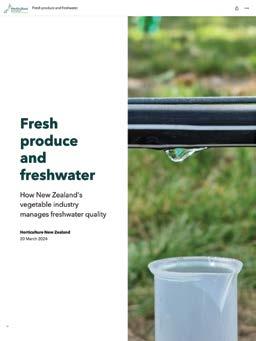

Source: 2023 NZGAP Activity Report (nzgap.co.nz)
See how fresh vegetable growers manage freshwater risks on the HortNZ storymap: Fresh produce and freshwater. Visit www.hortnz.co.nz or use the QR code
To find out if support is available in your catchment, visit the HortNZ website: www.hortnz.co.nz/compliance/farm-planning/freshwater-farm-plans/
HortNZ is proud of our industry and growers’ efforts to demonstrate credible environmental practice.
This collective progress provides critical evidence for HortNZ’s advocacy on behalf of growers in national and regional freshwater policy. Growers need continued access to freshwater, both for water takes and to discharge contaminants. To achieve this, we need appropriate policy settings underpinned by strong evidence and science. Industry led research and implementation is critical to show how the effects of growing on freshwater can be adequately managed through GAP and freshwater farm plans.
The journey of environmental improvement is more than just audited farm practices. It is rooted in research and industry codes of practice and a collective effort to identify and solve common environmental challenges.
HortNZ is supporting growers to develop freshwater farm plans through programmes like Growing Change. The project is in partnership with the Ministry for the Environment, funded through the Essential Freshwater Fund. Growers are supported with one-on-one professional advice to develop a freshwater farm plan, and have access to technical workshops on topics like nutrient, soil and irrigation management. Growing Change is also designing a micro-credential on managing freshwater risks from horticultural production based on industry codes of practice and guidance. The micro-credential will support consistent application of practices and tools by growers in their freshwater farm plans.


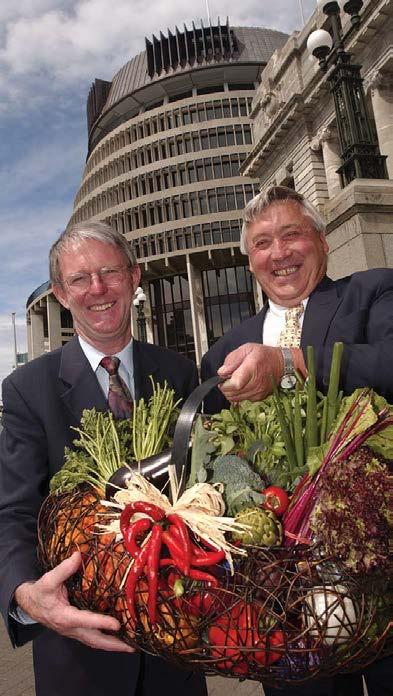
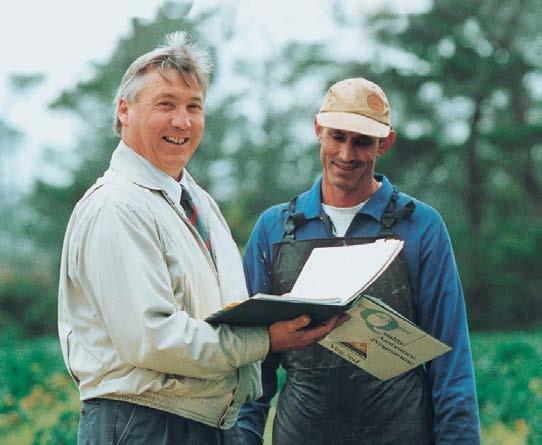
Some problems can be solved on the back of an envelope or a restaurant serviette, but 35 plus years ago, the conundrum facing Russell Jordan needed something much bigger. As big in fact as a sheet of gib board.



“Years later when the house was demolished, that gib board popped off the wall almost intact. I stood and looked at it for some time, remembering that night, before the digger destroyed it. It never occurred to me to photograph or keep it.” And so, a piece of NZGAP history was lost.
“Late one night I was trying to work out an auditing process for an NZGAP approved supplier programme,” says Russell, a grower who was one of the key drivers behind today’s NZGAP (New Zealand Good Agricultural Practice) scheme and the first vegetable grower to be awarded Horticulture New Zealand’s Bledisloe Cup.
“Jan and I were partway through renovating our house and in the hallway was a sheet of gib board ready to be installed, and a felt tip pen.”
Seizing the opportunity, Russell spent the night designing the basis of an audit programme on the board, including the idea of randomised audits and how frequently growers were likely to be audited.
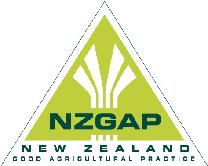
The story, however, illustrates the commitment Russell and many other growers and industry leaders had to the formation of a quality assurance programme devised by the industry, for the industry, which would provide assurance for consumers of the safe and sustainable production of fruit and vegetables in New Zealand.
Growers recognised that consumers were increasingly concerned about the origin and safety of their food and that they expected responsible and sustainable farming practices as well as the safety of workers.
Today NZGAP, which grew out of those early aspirations among growers in the mid-1980s, certifies that producers can demonstrate their commitment and ability to meet these expectations. NZGAP certifies New Zealand grown fruit and vegetables. Only certified growers can use the NZGAP logo.
This year NZGAP is celebrating 25 years of the first NZGAP certification outside of the pilots and development of the NZGAP programme.
There will be celebrations in Wellington with a cocktail event in April with retailers, wholesalers, regulators, product groups, district associations, select growers, HortNZ, excommittee members and NZGAP managers invited.
Growers recognised that consumers were increasingly concerned about the origin and safety of their food
The highly professional, internationally recognised NZGAP of today has come a long way from its beginnings. The quality assurance scheme’s initial focus was on grower and worker safety, Russell says.
“Bruce Woolley was chairman of VegFed when I attended one of my first meetings. The discussion was around the sad event of a grower killed at work and the need to get the whole of the vegetable industry on the same page, with some form of common goal around safety and to have a look at what growers’ legal responsibilities were.
“Initially it was seat of the pants stuff because we had no examples on or offshore to follow. We also wanted some formal means of identification for growers complying with the rules.”
Russell became chairman of the Fresh Vegetable Sector Approved Supplier Programme and went on to work closely with the late Ron Gall, who joined VegFed as an executive officer around 1984–5.
“I have three brothers and during the years we worked together Ron became my fourth brother. I spent a lot of time with Ron on a number of projects for a lot of years.”
Growers knew the government had plans to bring fresh produce into a food safety scheme and that if the industry didn’t devise its own quality assurance programme, a scheme would be imposed upon it.


NZGAP is celebrating 25 years since the first certification under the NZGAP quality assurance scheme
“Sandra Baldwin [from the predecessor of AsureQuality] and I spent a lot of time trying to nut something out and came up with an approved supplier programme around the end of the 1980s, and not long after that EurepGAP (now known as GLOBALG.A.P) turned up.
“What we conjured up matched much of what was in EurepGAP but they had a whole lot more money than us. We got a grant from the Agricultural and Marketing Research and Development Trust (AGMARDT) to fund the original manuals, and all the pieces started to come together.”
Some, especially smaller growers, were concerned about the financial implications of the scheme. “I even received death threats. But a remarkable number of growers could see the benefits and that was gratifying.”
Russell, a relatively small grower himself, was conscious that the scheme should be affordable and fair to growers no matter their scale. “That was one of the reasons for the randomised audits.”
It was around that time that Peter Ensor became involved in the Fresh Produce Approved Supplier Programme which evolved into NZGAP.
“The horticultural industry owes Peter a debt of gratitude. Peter talked the same language as those working on EurepGAP and helped us make necessary changes to NZGAP.
“I could see that our scheme should also include food safety, but I hit a brick wall as people were concerned doing so would be getting away from good agricultural practices.” Eventually Russell’s argument prevailed, and food safety became part of the programme.
Russell attended an AUSVEG meeting in Australia and heard Standards New Zealand were holding a two-hour meeting in Wellington.
“I got hold of Ron and suggested he should go along. A week or so later I was in Wellington and asked Ron how he got on. He tossed a couple of books across his desk and said; “didn’t understand a word they said”. The books were the ISO 9000 auditing process, from then on wherever I went those books went too.

the internationally and nationally recognised NZGAP green triangle.
On balance it’s a great scheme and I’m proud to have been part of its inception
“ISO 9001 has seven audit groups which aligned with how we wanted to audit NZGAP and formed the basis of the auditing system we have today. The seven audit groups were never meant to be set in stone but to be flexible and to evolve with the times.”
ISO 9000 is a set of quality management systems standards by the International Organization for Standardization that helps organisations ensure they meet customer and other stakeholder needs within statutory and regulatory requirements related to a product or service.
Initially NZGAP involved only vegetable growers until the summerfruit industry came on board. The turning point to almost universal involvement by both fruit and vegetable growers came, Russell says, when two supermarket chains and two marketers, T&G and MG would not take produce from anyone not involved in the scheme.
Russell also had a vision for a symbol or logo which would identify all quality assured product sold domestically or exported from New Zealand. Today that symbol is
Russell looks back with satisfaction at what the fresh fruit and vegetable industries achieved in establishing a professional quality assurance scheme and acknowledges that “too many people to name” played roles in its formation.
“So many were generous with their time, knowledge and advice and we were also lucky that Jim Sutton, in my opinion one of the best Ministers of Agriculture we have had, was the minister at the time we changed the name to NZGAP as he helped facilitate that.”
NZGAP has evolved and will continue to evolve as the industry and markets change. “It has the flexibility to include new requirements to be audited such as water quality and irrigation without the need to create a new system.”
Russell has retired from active involvement in industry affairs, although he and Jan continue to operate their Taranaki business Natural Fare which grows potted hydroponic culinary herbs for supermarkets and wholesalers.
“I still take an interest in what’s happening with NZGAP and mostly I’m happy, but some things annoy me a bit –that’s probably because after 40 years in the industry I’m a grumpy old grower. On balance it’s a great scheme and I’m proud to have been part of its inception.”
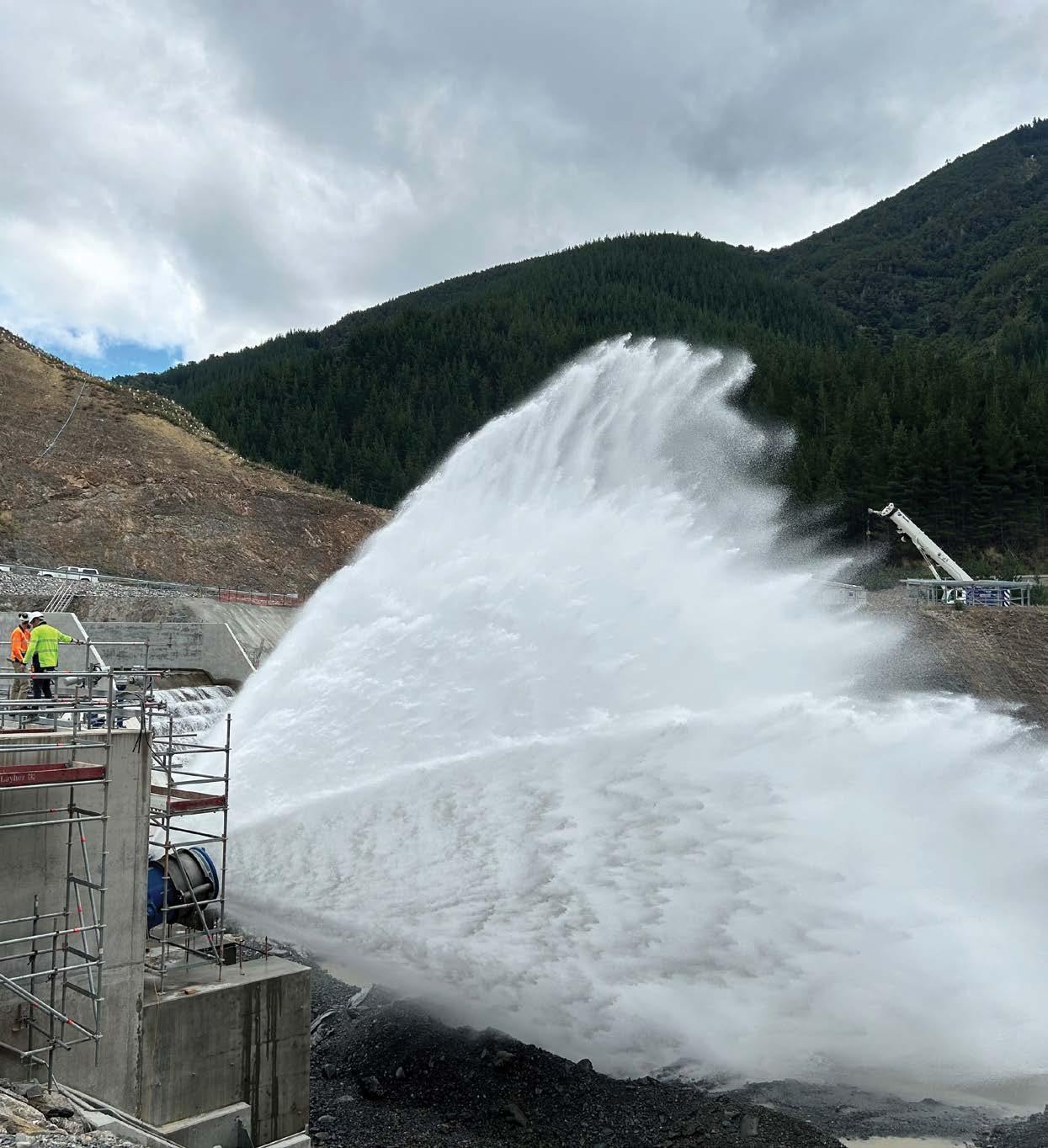

The Waimea Community Dam has been a quarter of a century in the making, but it is finally releasing water into the river to fill the aquifers and provide a reliable source of water for the next 100 years.
It ended up costing an estimated $198 million and was two years behind schedule, but for growers like Bruno Simpson at Waimea Nurseries, it is a huge relief to get to the finish line and he admits they got through the last two years ‘by the skin of our teeth’.
Behind the 53m high concrete face of the dam is the ability to hold 13 billion litres of water in its reservoir, Te Kurawai o Pūhanga, making it the largest public dam to be constructed in New Zealand since the Clyde Dam in the early 1990s.
It was back then, Bruno explains, that the idea of a dam was first mooted in Tasman as regular droughts took their toll on the productive Waimea Plains and urban communities. Then the 2001 drought hit – the Big Dry as it was named by NIWA (National Institute of Water & Atmospheric Research) – that was the worst regional drought on record and resulted in the Waimea River drying up in parts of the lower reaches, seawater incursions of some of the town water supply bores as well as irrigation bores and severe water restrictions. The region lost
millions of dollarsʼ worth of horticulture produce that year and it revealed an uncertain future for urban water supply as the population increased.
Climate volatility meant reliable water was no longer guaranteed and that brought together farmers, growers, iwi, Department of Conservation, Fish & Game NZ, the wider expanding community, commercial developers, the environmental sector and both local councils to collaborate on a dam project.
Eighteen potential sites were assessed for engineering, environmental and social factors before selecting the Lee Valley site for its ability to capture rain in its headwaters as well as the Lee River at its base feeding into the Waimea waterways and aquifers. To prove the point, in August 2022 a one-in-50-year storm event dropped 187mm of rain in the catchment that resulted in more than 30 million cubic metres of water flowing through the dam site. Enough to fill the reservoir two-and-a-half times in four days.
As dam plans were made, the costs continued to rise though, and ultimately the only way to get it over the line was through larger-scale irrigators digging deep into their pockets to buy surplus shares. Tasman District Council now owns 51 percent of the dam, paying for 21 percent of its urban share through water rates, charges and $5 million from neighbouring Nelson City Council. The other 30 percent of the council’s share is for environmental, economic and community benefits
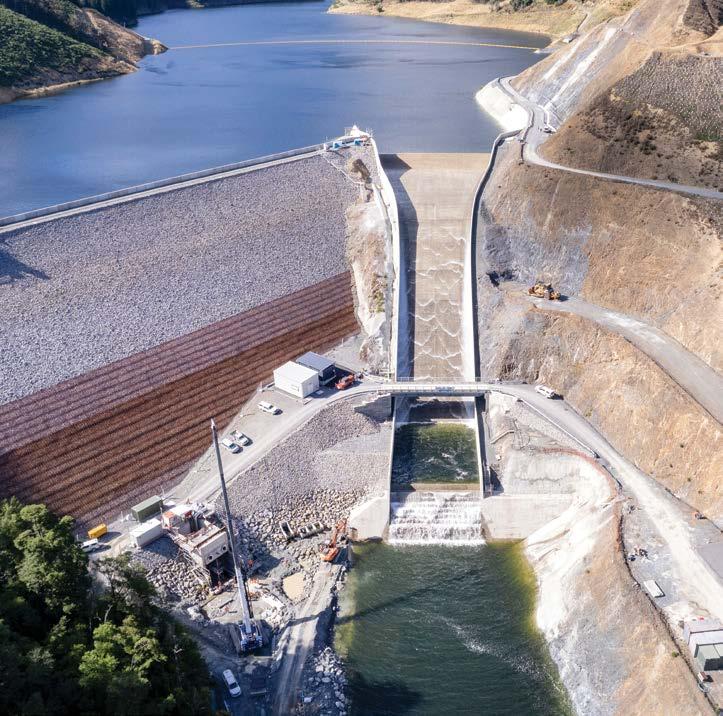
A full reservoir in January this year. Photo courtesy of Waimea Water which is funded by targeted rates, Crown Irrigation Investments Limited (CIIL) loans and enterprise income.
Because it is expensive water, the operating costs per annum will likely drive some changes in land use
Waimea Irrigators Ltd has funded the other 49 percent of the dam costs and it has done that by selling shares to irrigators and rural people, as well as securing loans from CIIL. Century Water is a company formed by a number of the larger irrigators who pulled together $11 million to purchase all the additional shares in the scheme above the 3000 shares purchased by Waimea Irrigators.
When the project was first presented to the public in 2017, it had a price tag of $79.5 million and by its
completion that had risen to $198 million. The biggest hurdle for the build and cause of increased costs was the discovery of highly fractured rock on the site, with multiple large shear zones (areas of ground rock and clay) bisecting the top of the spillway, plus weak rock under the plunge pool. Added to geology problems was the high inflation on the cost of materials and global supply chain disruptions, materials in short supply and the impact of Covid-19 on staff and productivity.
Bruno wears a lot of hats for the dam; as a grower and irrigator he is a Waimea Irrigators’ representative, plus he is deputy chairman of Waimea Water which is the company formed to build and operate the dam. He is also a director of Century Water that purchased the additional shares to reach the funding target.
He says that some of the challenges, such as unearthing geology problems, come down to limited funds at the outset and it’s a problem for numerous projects.


“It’s a real challenge. These schemes are hard to get off the ground because people need to put money that they don’t really wish to lose, into feasibility and investigations. People are reluctant to do it because it’s so hard to get these projects over the line from a consent and cost point of view. If you’re fighting on limited funds that no-one wants to spend, you do just what you need to do to make the investigations relevant.”
The other challenge with the project was finding the expertise, he says.
“The expertise in large, vertical construction projects like this is generally lacking in New Zealand. It doesn’t mean that expertise isn’t able to be brought to the project from offshore, and the project benefited from some immensely experienced people in the design side of the project, and even on the board of the dam company was dam construction expertise. Some of it came later in the project though and that means the project might have been delivered differently and been able to be completed faster if that expertise had been available from the outset and throughout the project.”
For irrigators, he says it would have been considerably cheaper to build on-farm water storage, but firstly, that would have resulted in numerous ponds across the Waimea Plains and taken up a lot of productive land cumulatively in order to have the reliability to grow horticulture crops.
13 BILLION LITRES OF WATER
$198 MILLION COST ON COMPLETION
Secondly, it would not have solved the water security issue for the entire community into the future. Whereas the dam has already supported developments such as Richmond West which he says would not have been able to go ahead without a projected future water supply, and provides water security for urban areas from Richmond to as far as Mapua. Just prior to the dam releasing water for the first time from the smaller of three permanent dispersing valves at the beginning of March, many of the urban communities including Richmond had reached Phase E water restrictions which meant households were not allowed to even water their vegetable garden from a hose. The council suggested they place a bucket in the shower to collect water.
When water was released from just one of the dam’s three valves at the beginning of March, those restrictions were instantly lifted in most areas and once again residents could water their gardens, wash their cars – and irrigate their crops and land to 100 percent of their consented maximum water take limit under pre-dam conditions.
A dam was undoubtedly the way to go, says Bruno, and though there have constantly been some grumblings from members of the community about the need for a dam and its costs, he thinks it is a vocal minority.
“The cost blowouts have not been ideal, but this scheme is still a reasonably viable one for the whole of the region.

“It wasn’t strictly about a return on investment because I can tell you that as an investment it stacks up very poorly. But it provides security to those existing growers, and I think for the future land users on the Waimea Plains it means that there will be potentially more demand for land here because the water reliability will be as good as anywhere else – or better than a number of places.”
At the beginning of the project, it was suggested the operating costs would be about $500 per hectare per year, but that has risen to about $1,050 plus GST per hectare this season.
Because it is expensive water, he says the operating costs per annum will likely drive some changes in land use toward more intensive horticulture crops. Only three dairy farms remain on the Waimea Plains and they have long accepted dairying does not have a long-term future there.
Now that the dam is flowing, Bruno says there is the potential to sell the surplus shares held by Century Water to irrigate a further 2300ha and as more people join the scheme, the scheme gets cheaper.
The dam was built with the capacity to support about 5000ha and Waimea Water says further uptake will be focussed on unaffiliated and partially affiliated area in the zone of effect, with some potential to draw water from the zone to areas on the fringe.
The Waimea Community Dam is not your typical dam that pipes water to where it is needed. There are no pipes leading from the dam. Instead, it releases water into the river and that will recharge the aquifers where bores take water.
Bruno acknowledges it will now be watched by other regions to see how it goes through severe droughts, and whether irrigators and urban supply do get the water they need.


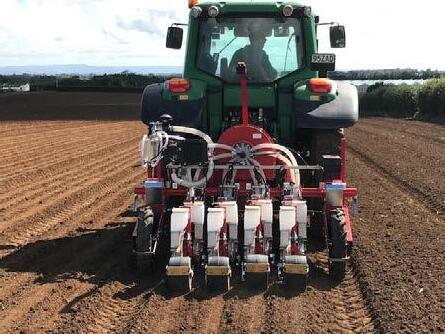

09
Bruno Simpson from Waimea Nurseries wears a lot of hats: as a grower and irrigator he is a Waimea Irrigators’ representative, plus deputy chair of Waimea Water, and a director of Century Water. Photo by Anne Hardie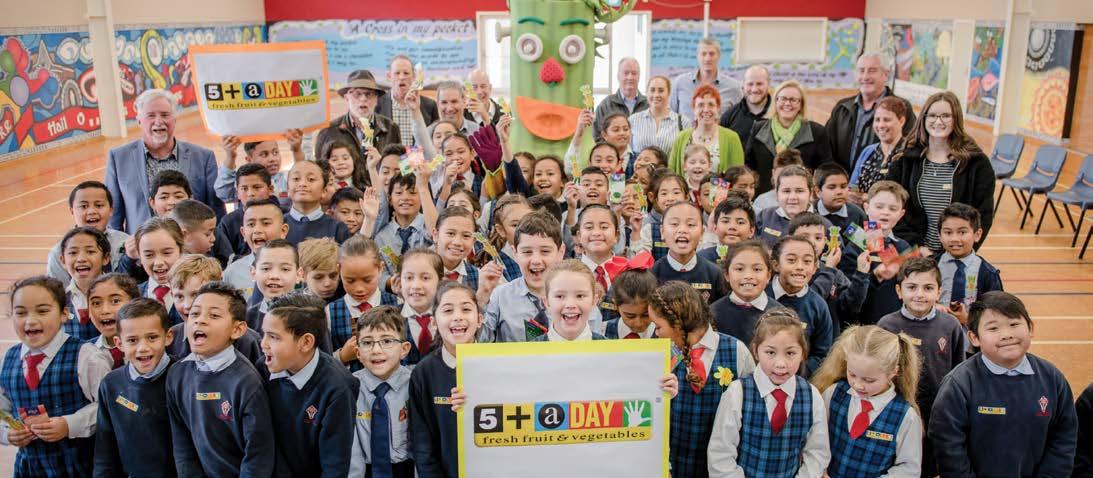
Horticulture is such a positive industry to work in given the health benefits of the fresh fruit and vegetables grown in Aotearoa, says Carmel Ireland, project manager at United Fresh.
“Encouraging, educating and enabling people, especially school children, to eat more fruit and vegetables, means that this is the ideal industry for me to work in,” says Carmel, who is also a member of Women in Horticulture (WiH).
Through her role at United Fresh, Carmel is involved in the Fruit in Schools (FIS) programme, part of the Fruit and Vegetables in Schools Programme, which provides fruit to more than 125,000 school students and staff each school day, equating to 127 million servings of fresh fruit and vegetables each year.
The programme, which delivers fruit and vegetables to 566 schools across 21 regions in New Zealand, is one Carmel cares deeply about.
“The programme has been running since 2005. Its longterm impacts include helping to address equity issues in our communities by making fresh fruit and vegetables accessible to children. It also helps normalise snacking on fresh fruit and vegetables so that children are treating them as a normal part of their diet.”
A recent independent evaluation conducted by Quigley and Watts on behalf of the 5+ A Day Charitable Trust which supports the Te Whatu Ora funded initiative, found that FIS rated as the most effective initiative at supporting a healthy kura or school environment.
Carmel says the survey’s feedback from principals was hugely affirming, but also showed the desperate need that still existed in the community.
“Food insecurity has reached even greater heights than before the (Covid-19) pandemic. The review shows just how hard it has become for whānau to put nutritious food on the table every day, with 93 percent of principals saying FIS supported them to feed hungry tamariki,” she says.
Principals interviewed for the evaluation highlighted that FIS helped them assist whānau with the high cost of living. Not only was some of the stress of providing fresh produce for tamariki removed, but kura were also able to assist struggling whānau by sending home excess fruit from time to time.
Carmel joined United Fresh in 2005, after working alongside United Fresh general manager Paula Dudley on a 5+ A Day programme in early childhood education centres, for the Heart Foundation.
“I was really impressed by the work United Fresh and 5+ A Day was doing and when an opportunity arose to join the team, I jumped at it. Paula has become a mentor for
me in my career and I enjoy being part of the United Fresh all-woman team.”
A career in horticulture was not on Carmel’s radar when as a young and talented track and field athlete, she gained a scholarship to study for a Bachelor of Science (BSc) Kinesiology and Exercise Science at the University of Illinois.
“It was a wonderful experience. Through playing a lot of sport, I was interested in studying health and fitness and their impacts on movement and performance, so took a nutrition paper as part of my degree,” says Carmel who grew up in west Auckland.
Back in New Zealand, Carmel decided to continue her education and interest in nutrition, completing a postgraduate degree in Public Health at the University of Auckland in 2002, followed by a certificate in Pacific Nutrition at the Auckland Institute of Technology in 2005. While horticulture was not her first choice of career, Carmel is now a strong advocate for the industry.
“Horticulture is a great industry to work in. It offers a lot of opportunities for women, including through the Women in Horticulture group which is supporting and empowering women in the industry and providing connections for women in the regions. We need more women to work in horticulture and to progress to leadership roles.”
United Fresh took over the leadership of Women in Horticulture (WiH) in April 2023 and held its first workshop late last year.
“The feeling in the room at the first workshop was so positive and supportive, we plan to run more events in 2024.”



 Carmel Ireland, project manager at United Fresh, is a member of Women in Horticulture
Carmel Ireland, project manager at United Fresh, is a member of Women in Horticulture
Dr Charlotte Drury : Consultant planner for HortNZ
Despite the summer not delivering to Hawke’s Bay the severe drought that was initially predicted, water allocation is still a hot topic for many growers in the region. This is because nearly 800 expired water permits are currently being considered by the Hawke’s Bay Regional Council.
Just before Christmas the regional council advised applicants the volume of water they are likely to be reallocated, and many growers are potentially looking at reductions of their consented paper allocation. The council’s aim with the reductions is to align consented paper allocation more closely with the volume of water growers actually or reasonably need to undertake their activity. In some cases, quite substantial reductions have been signalled by the council (i.e. reductions of up to 70 or 80 percent). This process has resulted in many asking the question why is our allocation being cut? In this article I will endeavour to explain the planning process that has got us here, what are the possible pathways forward, and what growers could or should be doing in light of this shift in approach to water allocation.
New Zealand’s approach to managing its freshwater resources arguably began to change in 2011 with the introduction of the first National Policy Statement for Freshwater Management (NPSFM). This was the first central government guidance issued under the Resource Management Act about how the country’s freshwater should be managed, and it was intended to drive national consistency in freshwater planning and decision making. It had four objectives relating to water quantity, which were to: safeguard the life-supporting capacity, ecosystem processes and indigenous species of freshwater; avoid future over-allocation and to phase out over-allocation; improve efficient use of water; and protect the significant values of wetlands.
The NPSFM was updated in 2014, and again in 2020 (and has also been amended a couple of times), and it is again under review by the newly elected National government. As it has evolved over time, the NPSFM has put increasing emphasis on the importance

of maintaining water in the environment, for the environment’s sake, and less emphasis on taking a phased approach to achieve that outcome.

The 2020 version of the National Policy Statement for Freshwater Management has a single objective, “to ensure that natural and physical resources are managed in a way that prioritises:
a) first, the health and well-being of water bodies and freshwater ecosystems,
b) second, the health needs of people (such as drinking water), and
c) third, the ability of people and communities to provide for their social, economic, and cultural well-being, now and in the future”.
The NPSFM required regional councils to set objectives and limits for all freshwater bodies in their region, and avoid over-allocation (in terms of both water quality and quantity). In the Hawke’s Bay region, the first cab off the rank was the Tukituki Catchment, with the planning provisions relating to that catchment becoming operative in 2015. The TANK (Tūtaekurī, Ahuriri, Ngaruroro and Karamū Catchments) were the next to be tackled by the regional council, and a collaborative group was formed to start developing a plan change in 2012. One of the most difficult topics that the plan development group grappled with was water allocation. Science was presented to the group that showed that the groundwater resource under the Heretaunga Plains was declining, and therefore the current level of water allocated from it was not sustainable. This means (from a planning perspective) that it was over-allocated, and therefore somehow the level of water allocated from it needed to be reduced and new allocations avoided. While many in the community are questioning this science (and are entitled to do so), in terms of a planning process, no party involved in the TANK Plan Change process has challenged it, therefore that is the information that must be used on which to base decisions. There are a range of methods that can be used to reduce allocation.
Some of these include pro rata reductions, where all water users are reduced by a common amount, say 15 percent. Targeted reductions are another option, where perhaps bigger water users lose more than smaller water users who arguably have less flexibility. In the TANK Plan Change the allocation mechanism chosen was an ‘actual and reasonable’ use test. The actual use was based on historic water meter data, and the reasonable use component was based on a crop water demand calculation (in this case IRRICALC, but again, there are a number of different crop water calculators used throughout New Zealand – APSIM and SPASMO being two others that have been used at times in Hawke’s Bay). The concept behind the actual and reasonable test is attempting to cap water abstraction at a volume that relates to a baseline period (May 2010 to May 2020). This approach is designed to avoid further over-allocation, by not consenting increased abstractions compared with the water that actually or reasonably was needed to support the activities that irrigators were undertaking during the baseline period.

Live in beautiful Kerikeri. Be your own boss whilst earning an exceedingly high income. This is it!
Located just a few kilometers from Kerikeri town is this Scandinavian influenced home with amazing features such as high pine ceilings, stone feature walls, double glazing, three large bedrooms plus office, fabulous kitchen, generous decks and double garage. This is an exceptional home. And then comes the income and the life! The current owners have over several years established a highly successful export orchid growing business. Their busy time is over the winter months, and summertime is primarily leisure. Once you are the lucky owner your core work processes are to care for orchids within the hothouses until flowering starts in May. Once flowering starts its picking and packing into export boxes, and they are then off to the exporters. It’s a simple operation and easy to learn. The current owners will assist you with training and oversight. This is a financially proven business set up for big profit over the 2024 season. Net profit after owner wages and after all operating costs in 2023 was over $250,000. A similar result is forecast for this year when you can be the owner. This property and business will sell! Don’t miss an excellent opportunity for a new life and high income. Enquire now! Bayleys.co.nz/1003929
bayleys.co.nz/3150867



All allocation mechanisms have pros and cons. It remains to be seen what those are with the actual and reasonable use test. At present the Hawke’s Bay Regional Council is taking a very narrow interpretation of it, essentially only looking at actual use, and putting aside the volume that could reasonably be used to produce a particular crop. What makes the potential impact of this approach difficult in Hawke’s Bay is that there is currently no means of accessing harvested and stored water to reduce the risk of capping groundwater allocation.
The water storage conversation has had new life breathed into it by the new government. There is increasing hope of progress on water storage in the Tukituki Catchment, however large-scale storage serving the Heretaunga Plains is years from being realised. It is generally agreed that storing water is a good concept, however views about the mechanics of how and where that is done, and by whom, are far more divergent and would need time to navigate. In the meantime, how do growers not just survive, but ideally thrive?
As the planning framework continues to evolve in this space, it is challenging to give clear advice about what growers should be doing. However, irrespective of the exact policy settings moving forward, it will be important for all growers to: understand the water demands of their crops and growing systems, Understand the efficiency gains that can be achieved with improved irrigation technology, and keep high quality water use records.
A good understanding water use data is key to improving growers’ management of risk associated with water allocation settings. Some growers look at their water meter data regularly, others do not even know how to access it. You need to get familiar with it – find out what works for you in terms of the way you can understand it best. Many regional councils will have staff that can assist you with this. You need to understand your water use so that you can pick up any anomalies, and intimately understand your water use profile. This will only stand you in good stead in future water permit replacement processes.
There is also more and more talk about the opportunities and increased flexibility that collective water management may offer. In Hawke’s Bay we have an outstanding example in the Twyford area. The establishment of the Twyford Water Users Group, and the global consent that they operate under was trailblazing, and continues to be held up as an exemplar of how a common pool resource can be effectively managed. However, the way the actual and reasonable allocation approach in the TANK decision landed, the efficiencies gained by the growers operating collectively may be clawed back, which is an outcome that penalises the most efficient water users.

Global consents offer a real opportunity to optimise efficiency, but these management frameworks do challenge regional councils and existing static planning instruments. They also require a shift in thinking for growers – moving from an individual water permit to being part of a group that collectively manages the water resource.
Water allocation will continue to be a hotly debated topic for some years to come. Horticulture New Zealand is advocating for water allocation frameworks that are designed in a way that rewards water use efficiency and are phased in at a rate that enables growers to reduce reliance on over-allocated water sources as harvested and stored water becomes available.
Against that backdrop of uncertainty, ensuring that you understand the water demands of your crops and growing systems, the opportunities for improved irrigation efficiency, understand your water records, and account for the risk of water allocation in business decision making are the practical things you can do to position your business so you can continue to produce good healthy fruit and vegetables for consumers in New Zealand and overseas.

Vegetables New Zealand is seeking a Future Director to serve and gain experience on its board.
This year-long appointment commencing in August 2024 will allow the successful appointee to gain experience in governance, leadership and strategy. This position will suit an applicant who has active involvement in a horticultural enterprise, giving them an understanding of the issues and challenges that horticulture and growers face.
This is a great development opportunity for a future leader with a genuine interest in governance. The Future Director will have the opportunity to be mentored by an industry leader and receive governance training. In making the selection, the Vegetables NZ diversity policy will be taken into account.

The job description can be found at: freshvegetables.co.nz

If you are interested in this role, please send your CV and cover letter to: andrew.bristol@freshvegetables.co.nz

Applications are OPEN and CLOSE at 5pm, Friday 21 June 2024. The successful candidate will be announced in August followed by an induction during August/September. Their first board meeting will be in late September 2024.

For 25 years the Opuha Irrigation Scheme has brought prosperity to South Canterbury farmers and growers along with supplementing Timaru’s water supply and minimising the effects of flooding.
When the proponents of damming north and south branches of the Opuha River, just north of Fairlie, to store water for irrigation went looking for investors, they chose a tough time to do it.
“The mid-1990s were difficult economic times,” says Opuha Irrigation chairman Ryan O’Sullivan. “It was near the end of ten really tough years in farming, both climatically with three years of severe droughts in the 1980s, as well with Rogernomics which really pulled the rug out from under farming.”
The Opuha scheme was the first to be built after a huge shake-up in the way irrigation schemes were constructed and managed in New Zealand. Until the 1980s they were generally built by the Ministry of Works, but that changed when the National government of the day abandoned the partially constructed Maniototo Irrigation scheme in Central Otago because of a budget blowout.
When Labour came to power in 1984, Finance Minister Roger Douglas not only abolished farming subsidies, he
also got the government out of the irrigation business altogether and all the state-owned schemes were sold to the farmers who used the water.
With no central government support forthcoming, the group of enterprising individuals who drove the project had to find another way to pay for it.
“It was a local initiative with local people finding solutions to local problems, so it really was cap in hand to anyone who would listen and there was no central government money as such,” says Ryan. “While it was only $34 million, it was a hell of a lot of money back in those days and it was certainly challenging.
“There was funding assistance from local government and the local lines company but it was really farmers, bank finance and one of two underwriters in their private capacity that got the whole thing off the ground.”
The 300-metre wide, 50-metre-high dam holds roughly 73 million litres which is used both to irrigate 16,000ha as well as provide environmental flows for the Opuha River, as well as the Ōpihi River of which the Opuha is a tributary.
“In very broad numbers there will be about one fill per season applied to land for irrigation and another three fills are used to supply environmental flows, so generally it turns over about four times a season.”

The Opuha Dam’s 7-megawatt turbine generates power for the local network, on average powering 4000 to 5000 homes “We’ve got 25 years of service now. It was designed for 95 percent reliability and it is achieving that or better.”
Bringing reliable irrigation to the region has been transformative for South Canterbury which previously struggled to match neighbouring Mid Canterbury’s agricultural prosperity because it doesn’t have the same reserves of groundwater that can be accessed by bores. Additionally, the big alpine-fed Canterbury rivers from which other districts draw irrigation water don’t flow in this corner of the province.

Opuha Irrigation has commissioned a number of economic studies over the years, and they show the scheme is an important contributor to the local economy. “Admittedly those studies are getting pretty historic now, but you’re talking annual benefits accruing of $100 to $200 million annually so that’s a lift of GDP (gross domestic product).
“These irrigation schemes change land use, more intensity, higher cost structures, therefore spending in the community with more jobs, more wages and more rates. The economic impact of that is pretty well documented and it’s extremely beneficial for the local economy.”
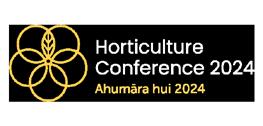

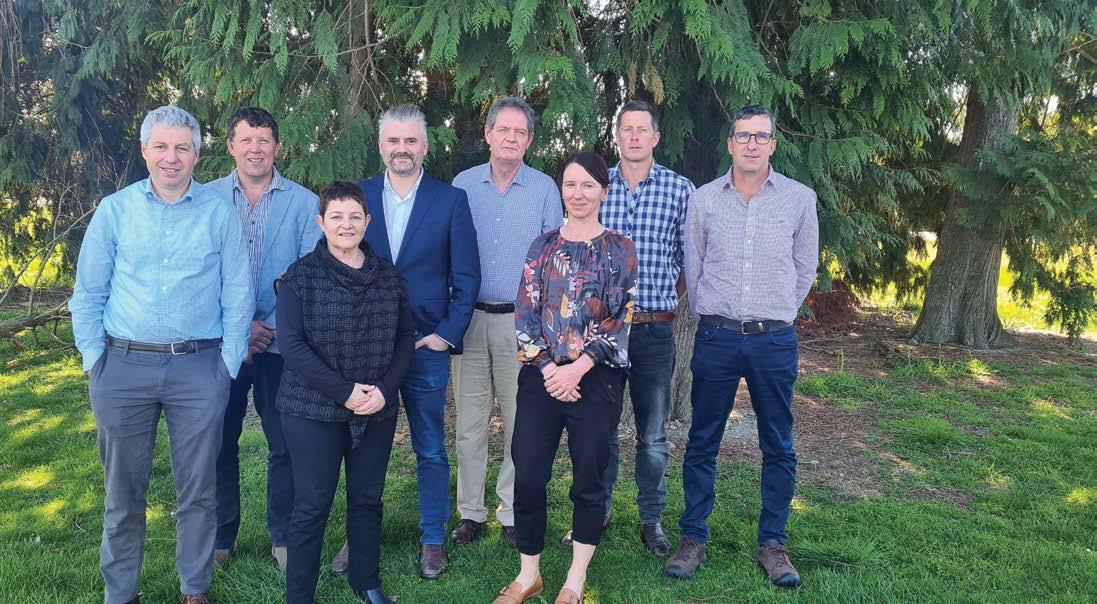
A relatively small amount of Opuha’s water is used for horticulture, only four percent, compared with 50 percent for dairy farming, with the remainder going to arable, dairy support and Timaru’s water supply. But Ryan says horticulture is expanding in South Canterbury, especially near the coast.
“Apples seem to be getting a strong foothold in South Canterbury. We have a couple of shareholders who are into Honeycrisp and Rockit™ apples and that’s a good alternate land use. Berries and blackcurrants are proven in South Canterbury too.
Opuha Irrigation has commissioned a number of economic studies over the years, and they show the scheme is an important contributor to the local economy
“With climate change, in another ten or 20 years do we have grapes or kiwifruit in Canterbury? You couldn’t rule it out, and we’ve got the infrastructure there with the port and really good logistics, expertise and engineering.”
The scheme’s not only an important contributor to the local economy, it also played a vital role in moderating the effects of flooding in 2021, holding back much of the flow from the back country thanks to spare capacity behind the dam at the end of the irrigation season.
“The lake level was 12 percent pre-event, and post-event it was 85 percent, so we were able to swallow a lot of water into the reservoir,” says Ryan.
“The Ōpihi River measure at Pleasant Point reached around 800 cumecs, and the flow at the State Highway 1 bridge further downstream was higher again at over 1000 cumecs, with substantial flows backing up the Temuka River system. Had the Opuha Dam not held back the high flows in this catchment, which peaked at 452 cumecs, the lower reaches of the Ōpihi River system would have been higher again with likely substantial more community damages as the result.”
“That was a real recognition, even from ourselves but particularly the wider community, of the benefit the dam brings to flood attenuation.”
When water flows from the dam it turns a 7-megawatt turbine that generates power for the local network. There tends to be a massive swing in the amount generated each year; that depends on the season. “We generate when we release water, and we don’t generate when we’re trying to fill the lake, but on average each year it powers 4000 to 5000 homes. It’s quite a useful offset to our operating expenses.”
Opuha Dam has fulfilled the dreams of the enterprising individuals who pushed hard for its construction, bringing reliable water to farmers as well as benefitting the local economy more widely. Now much of the focus is on earning community support to help ensure the scheme maintains its licence to operate.
“We take our obligation around preserving or enhancing water quality seriously, and we actually have our own freshwater ecologist and environmental team of three, and we’re developing a really good database of water quality monitoring sites.
“We want to be able to demonstrate we’re not having an adverse impact.”
Whether there’s potential for more irrigation schemes to be built in Canterbury, Ryan’s not sure, especially since two proposals over the past few years, one in South Canterbury and another in North Canterbury, failed to get sufficient farmer support.
“It’s just a matter of finding the water source that’s not already fully committed, and that’s a difficult conversation because one person’s over-allocated is another person’s ‘there’s still heaps of water available’, but we do let a hell of a lot of water go to sea in Canterbury, especially from the big rivers in flood.”
He’s not expecting the state to step back into irrigation like in the old days, but hopes the new government may be
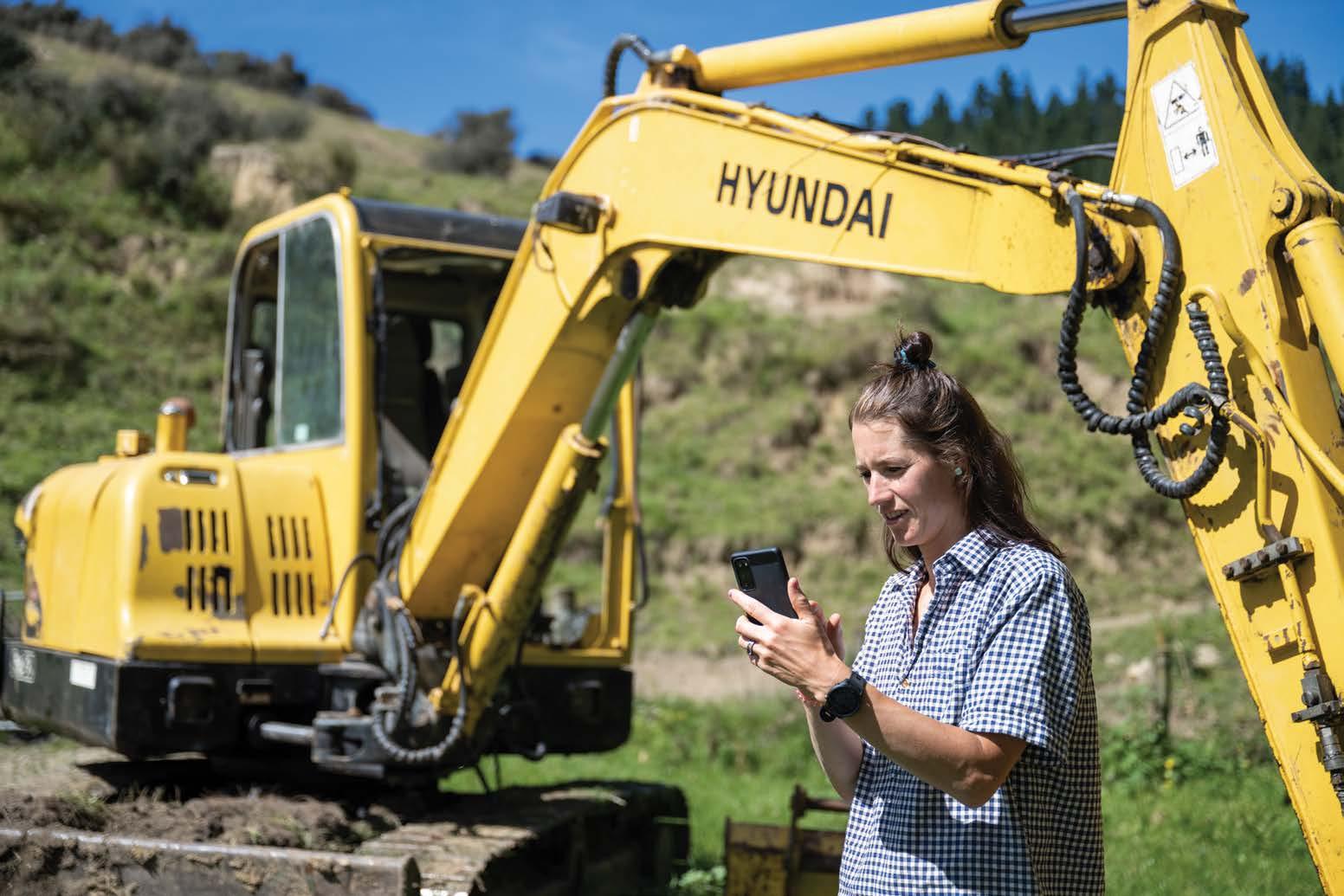


After losing most of the onion crop last year in Cyclone Gabrielle, Hawke’s Bay growers are pleased with what has been a good growing season.
In the main there were no major weather events, the crop established well and was then followed by consistent and moderate rainfall and lovely sunny Hawke’s Bay weather.
Chris Zuiderwijk, Bostock growing operations manager, says the onion crop is planted in July to August and harvested between February and early April. The long growing season makes it a technically difficult crop to grow.
“You have a very spindly little onion. When the onions are very small they are very susceptible to rainfall events. And then you need to get through your weed control, which is the most difficult period. They are in the ground a long time, vulnerable to the elements over winter and early spring and take a lot of effort to grow.”
For the more than 200ha of onions that Bostock grows, volumes this harvest are above average.
“For Hawke’s Bay, 75 tonnes would be average, which is really good. That is better than normal. And we got above average yields this year.”
One of the issues that can hamper crops is called ‘capping off’. Because of Hawke’s Bay’s clay soils, any heavy rain followed by hot sun can result in a hard crust that prevents the seedling breaking through.
Another issue is Stemphylium, a mould disease that can hit crops quite hard when the levels of humidity spike through November. But this was very limited this year, he says.
“The back to normal better Hawke’s Bay conditions, with lower humidity days has helped,” he says.
Agronomist Dereck Ferguson says the onion crop the year previous had been doomed from the get go.
It started with a tough wet winter which prevented some growers getting all the seedlings in the ground, perhaps only 60 percent of what was wanted. Then there was a hailstorm on Christmas eve that took out much of the crop, and then through January the weather trouble continued.
“Gabrielle was just like another nail in the coffin at that point and we lost even more.”


Growers are seeing respectable yields this harvest
Onions are in the ground a long time and vulnerable to the elements This year’s crop is a different bucket of onions, so to speak. The growing conditions were good, but not without challenges. Growers still encountered mildew and Stemphylium, but this dried up and growing conditions tracked well leading up to Christmas, he says.
“The issue we faced from then was bolting, relating to cold snaps back in spring. The plants mistakenly think they have gone through vernalisation in winter and start sending up stems and flowers, so instead of an onion bulb you get seeds, which makes the bulb unsalable.”
Normally growers might get one to three percent bolting in a paddock, but this season the numbers were far higher – and at the end of the day, that means a haircut for the grower both from yield loss and the cost of pulling them out.
“That was a bit of a downer on the season, but this was to do with our climatic conditions and when we planted,” Dereck says.
At the time of writing, harvest is ongoing. Dereck thinks it’s shaping up to be a pretty good year with respectable yields, and if the market receives the products well, then growers will be happy.
James Kuperus, chief executive of Onions NZ, agrees that the crop quality is very good.
“Grower resilience has certainly been tested, not just with the cyclone but also continued higher rainfall last year, so to come out the other side of last season like we have with much more favourable conditions is good news.”
Getting a good return for such a high quality product is the next challenge, he stresses, with demand sluggish in some key export markets.
Onions NZ is also involved with continuing research into the impact of last year’s severe weather.
“There is some ongoing work trying to understand the long-term effects of that high amount of sediment on the soil.”

The onions commodity levy expires early 2025.
We are currently consulting with onion growers on the renewal of it, including the maximum rate, how it is calculated and the activities which can be funded with the levy.
We are proposing no changes to the maximum rate, or the way it is calculated and only minor amendments to the wording around the activities. This can be found at www.onionsnz.com
The vote will occur Mid-May. At this stage, we are seeking feedback on what’s proposed and for growers to contact us if you’re not receiving our communications to ensure we have accurate details.
Please contact James to provide feedback or to update details:
James.Kuperus@onionsnz.com 027 555 0072
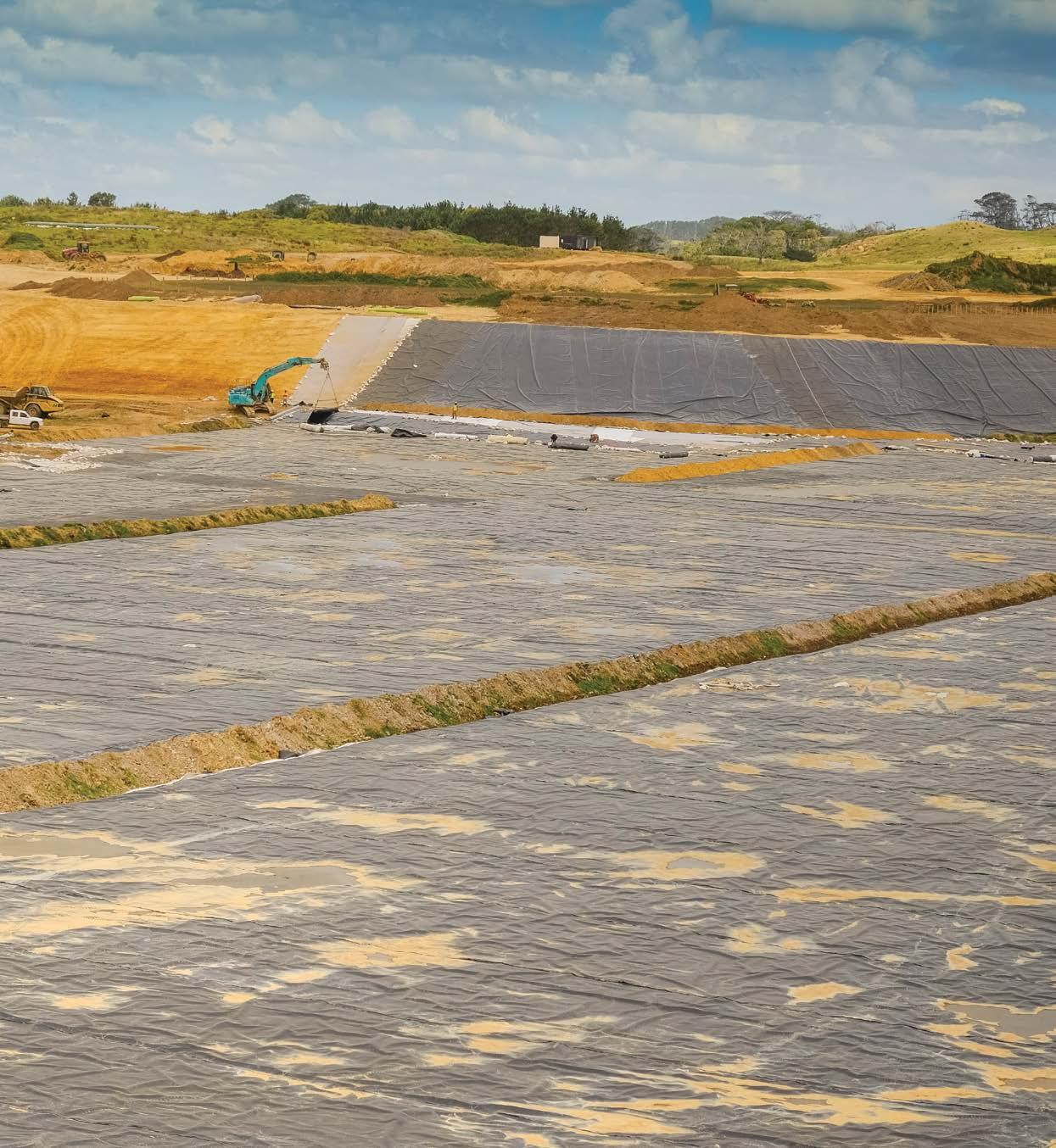
40 WATER STORAGE SOLUTIONS
Photo by Trefor Ward
Georgina Griffiths : MetService meteorologist
And how did it compare with a typical El Niño summer…
El Niño, characterised by warmer sea temperatures near the equator in the eastern Pacific, varies in global intensity and impact. Growers in Gisborne and Hawke’s Bay typically expect dry summers under El Niño – but what happened this time?
A quirk of our current El Niño is that it occurred during a time when all global oceans were much, much warmer than normal – meaning that this El Niño didn’t really stand out from the crowd.
Additionally, we were coming out of a rare long-lived La Niña event, which research suggests can have lingering effects.
All of this likely affected the downstream effects of our El Niño.
Despite this oddity, it is still considered a strong event, the first in eight years. We measure El Niño strength through
December
Higher than normal air pressure sat just to the north and the east of the North Island, overall bringing a northwesterly wind anomaly. However, there were occasional fronts stalling over the upper North Island with high pressure building to the south, bringing a few rain events to Gisborne and Hawke’s Bay.

indices like ONI (Oceanic Niño Index) and MEI (Multivariate ENSO Index).
The former measures only sea surface temperature anomalies in the eastern tropical Pacific, and the latter measures a broader response which includes the atmosphere. This event peaked at 2.0°C in the ONI and 1.1 in the MEI.
To find comparable historical events (analogues) to this strong El Niño, we set a fairly high threshold of 1.5°C for the ONI, and 1.0 for the MEI. This generates eight comparable historical analogues since 1972.
Due to space considerations, and their long, consistent climate records, this article will just focus on statistics from Napier and Gisborne airports. We will compare against both the 30-year climate averages, and against our El Niño analogues.
While there were no major individual rain events, Gisborne still had 100 mm of rain – (156 percent of normal). Meanwhile, Napier trickled in at near-average rainfall (49 mm versus 58 mm).

Higher than normal air pressure to the east of the North Island brought an anomalous northerly flow over the country. This made January the hottest month of the summer, but there were also a few rain events.
Similar to December, these resulted mainly from fronts stalling in the region, rather than moving through quickly,
With high pressure becoming dominant just to the north, and low pressure to the south, February brought about a significant change to the pattern compared with early and mid-summer.
FEBRUARY MONTHLY RAINFALL IN GISBORNE SINCE 1972
hence January was a wet month in both Napier (240 percent of normal) and Gisborne (180 percent of normal).
Outside of the rain events, there were numerous hot, dry days. Napier reported five days exceeding 30°C. While significant, it pales in comparison to the famous El Niño February of 1998 which recorded eleven days over 30°C.
It finally resulted in weather that many people closely associate with El Niño. Both Napier (42 percent) and Gisborne (47 percent) reported well below normal rainfall – this was Gisborne’s first below average rainfall month since August 2023.

In the text opposite we have compared monthly rainfall data with the 30-year climate averages. But how did summer 2023–2024 stand up next to our eight historical analogues?
Clearly, both December and January were wetter than normal compared with climate averages, but more significantly so in comparison to the historical El Niño analogues. This story did not continue in February, where 2024 stands out as dry even by comparison to historic Niño events.
Warm days (>25°C) showed a modest increase on historical El Niño summers. This appears to be a pattern over the last
decade or so, with the ten-year moving average showing a generally consistent upwards pattern almost regardless of El Niño/Niña status.
Summer 2023–2024 was uneven, and cannot be summed up as being dominated by one type of weather pattern. The unevenness appears even more accentuated when compared with our analogue years.
The long-term median is depicted as a white line, while the area between the 25th and 75th percentiles is shaded dark grey (i.e. 50 percent of all years lie in the dark grey shaded area). The area between the 10th and 90th percentiles is shaded light grey.


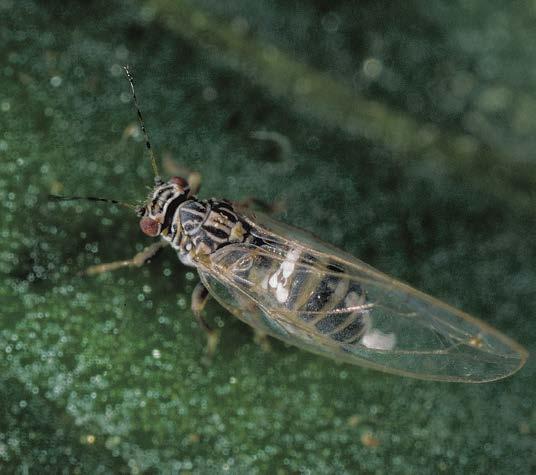
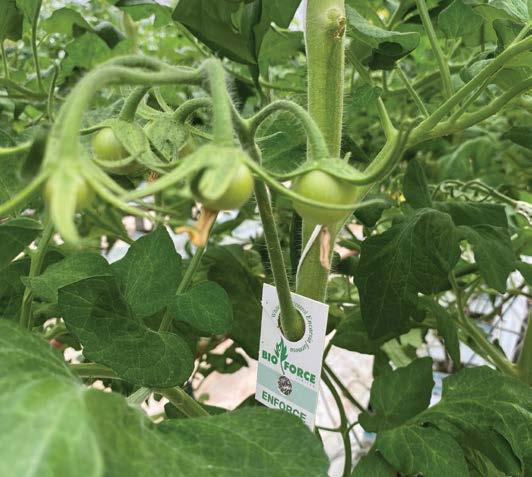
A TomatoesNZ project in conjunction with A Lighter Touch is aiming to change the face of pest management of greenhouse tomatoes, moving the industry back to integrated pest management (IPM) centred on the biocontrol of insect pests. For the NZGrower, the project team shares findings so far.
First season results from a project demonstrating the biological control of two major greenhouse pests show greater suppression of the pest population using natural predators than with a full chemical approach.
The New Zealand native predatory mirid bug Engytatus nicotianae has been identified as having the potential to be a useful biological control agent (BCA) in the battle against greenhouse whitefly (GHW) and the tomato-potato psyllid (TPP).
Laboratory feed trial data published in 2022 by Emiliano Veronesi (of Lincoln University) indicated that E. nicotianae is a generalist predator that completes its entire life cycle on various prey species, including GHW and TPP. The Lincoln laboratory trials demonstrated E. nicotianae’s feeding preference for juvenile TPP.
Across four of seven replicate cage studies, TPP establishment was prevented.
The biocontrol project took the knowledge gained through the Lincoln University trials and applied it to the biological control agent trials conducted as part of the TomatoesNZ / A Lighter Touch project. It aimed to determine:
• If E. nicotianae was introduced together with another BCA Encasia formosa, would they be able to successfully establish in the greenhouse through predating on GHW and TPP, and
• suppress these pest species to an economically acceptable level.
Two greenhouse sites were selected for the BCA demonstration project. Site 1 consisted of an older style low-roofed plastic structure totalling around 3000 sq metres. Site 2 was a Venlo style high-stud of about three hectares, separated by a glass wall into approximately a one-hectare trial house and a two-hectare control.
Site 1 was completely dedicated to the use of BCAs. At Site 2, one hectare was solely based on BCA control while the two-hectare house was treated with standard chemical spray protocols.
Greenhouse 1 (Encarisa & Engytatus IPM Strategy)
Greenhouse 2 (Agrichemical Strategy) Economic Crop Damage
Soon after planting, the predator E. formosa was introduced at a rate of three per metre2. The rate was modified throughout the season based upon the GHW population observations of the crop scouts. Introduction of E. formosa continued weekly.
E. nicotianae, whilst predatory in nature, can also survive on certain plants, and for the demonstration was introduced in the greenhouse on tobacco ‘banker’ plants at the rate of nine plants per 1000m2. (Banker plants consist of a non-crop host plant harbouring a natural enemy,)
Scouting was undertaken on a weekly basis using the scouting protocol developed for the project and available on the TomatoesNZ website. The scout moved through the rows looking for anything unusual, including any plant damage, residue, bugs on sticky traps, or bugs present on leaves.
If no signs of bugs were observed, the scout would stop randomly every six to ten metres and examine the underside of five to ten leaves for bugs, larvae or eggs. This approach is based on a Lincoln University statistical analysis of GHW populations which indicated that as long as 50 sites within a greenhouse were examined, an accurate average measure of the GHW population can be established (site size was not relevant).
We are searching for a Senior Manager to lead our established Horticultural operation.
We have 200 hectares under production and employ over thirty full time staff spread across two sites in North Canterbury. See www.scottfresh.co.nz
Once scouting was completed, any areas of higher than acceptable pest population were identified and additional BCAs distributed accordingly.
Shortly after planting, the greenhouse had a GHW population ranging from low (zero per plant) to high (maximum of 100 per plant) with an average of 27.
The E. nicotianae banker plants were placed on the centre path at row ends. E. formosa was introduced in the form of standard cards, each containing 150 parasitised GHW scale.
After three weeks E. nicotianae had not been observed more than five metres from their release point. A decision was made to break parts of the leaves off the banker plants and distribute them down the rows. This led to rapid establishment of E. nicotianae around the site. At this stage GHW numbers were static.
In the two to four weeks following leaf fragment distribution, the GHW population was visibly reduced. One month after distributing leaves through the house, GHW became difficult to find. From this time onwards, GHW were of no economic issue.

• North Canterbury based role – flexible living / hybrid work options
• Strong remuneration package
• Must have people leadership and P&L competencies
• Horticultural or other Agribusiness production experience required
To enquire about this role in strict confidence or to request a briefing document, please phone Deb Francis from AgRecruit on 021 2245000 or submit your leadership profile via www.agrecruit.co.nz
 The graph demonstrates the efficacy of the combination of E. nicotianae and E. formosa for control of greenhouse whitefly in the BCA house, versus the control house
The graph demonstrates the efficacy of the combination of E. nicotianae and E. formosa for control of greenhouse whitefly in the BCA house, versus the control house
No insecticides were applied on this crop.
Site 1 is in what would be considered a medium TPP pressure location, and at no time did scouts observe a single TPP or signs of their presence (sugars or TPP yellows, adults on yellow sticky traps). This was unusual, as historically the site would have experienced multiple TPP incursions in a season.
Site 2
E. formosa was introduced the week after planting and the rate was increased from three per metre2 to ten per metre2 at the request of the grower, who was concerned at potential carry over pests from the previous season and elsewhere on the site. A month later the rate was decreased to three per metre2 and remained there for the rest of the season.
E. nicotianae banker plants were also introduced a week after planting at the planned rate of nine plants per 1000 per metre2, with plants being placed on row ends. Following the success of the plant leaf fragment distribution at Site 1, the same strategy was employed here.
A TPP incursion occurred in February and E. nicotianae was observed predating on all of the developmental stages of TPP but not the adults. Observations were made that the TPP population appeared to be somewhat suppressed, however the presence of ‘hot’ TPP meant that the infestation required hasty action. (Hot TPP refers to TPP that are carrying Candidatus Liberibacter, which kills the plant.)
A single spray of Spiromesifen was applied late in February and this was enough to eliminate the ‘hot’ TPP population. After the initial hot TPP incursion, scouts encountered no further TPP in the BCA area.
A positive aspect of this crop was that GHW remained at acceptable levels until week 32 of the season. Over the next seven to eight weeks, it then climbed to approximately ten per head at week 39.
In the BCA house, the grower wished to start his new crop with very clean houses, and so ten weeks out from the end of the crop cycle made the decision to clean up using a chemical intervention to assist with this.
Conclusions
Site 1 Conclusions
This site demonstrated that an entire season of GHW control can be achieved through the use of E. formosa and E. nicotianae. While there were some GHW present, they were not at levels to economically impact upon crop production.
As this trial operated without a control house, the project team was not able to definitively say that E. nicotianae was responsible for the absence of TPP. However, this was a promising observation and this site plans to manage its next season with the same biological controls.
Site 2 Conclusions
This site also demonstrated good GHW control for the majority of the crop. The decision to use chemical control at the end of the crop (the last ten weeks) was driven by a desire to go into the next new crop with totally clean houses.
The scouts found no additional TPP (after the initial hot psyllids issue) for the rest of the crop.
One significant difference between successful IPM systems and conventional chemical spraying is that with IPM, growers need to tolerate some levels of pest population. Different growers will have different tolerances of what level of pest population is economically viable, but the trials have shown that GHW can be managed to levels that do not significantly affect production.
These trials are ongoing in the 2023–2024 production seasons. Both of the trial sites are continuing to use E. formosa and E. nicotianae as their primary controls against insect pests.
At Site 1, the trial will be exactly the same.
At Site 2, the efficacy of E. formosa and E. nicotianae was such that the grower has chosen to run with E. formosa in both the trial and control houses. E. nicotianae has also been introduced on banker plants in the trial house. It has also been noted that some E. nicotianae has migrated into the control.
In addition to the above sites, a number of other trials are also taking place. All of these trials are using E. formosa as the base BCA, with other beneficials being trialled to try and add to the pool of tools available to tomato growers.
The TomatoesNZ / A Lighter Touch trials are also about learning how and when to apply the BCAs and at what volumes. The project team is building its knowledge base and seeking the most effective way to communicate this among tomato growers.
The project team has identified that as well as gaining an understanding of how beneficial insects work, it also needs to develop resources that explain what to do, and not to do, at a practical level.
Workshops were held in 2023, for which a video and decision tree on GHW control were created. These can found on the Tomatoes NZ website. Further workshops are planned for 2024.
One of the largest hurdles for growers to overcome is the focus on 100 percent clean crops, i.e. zero pests. More work needs to be done on developing grower understanding of the equilibrium that is needed between BCAs and pests.
A Lighter Touch projects are all based around researching options that allow growers to have more sustainable production futures.
The tomato industry is currently showing a significant shift towards BCA-based pest management programmes.
A survey when the TomatoesNZ / A Lighter Touch project began found only 50 percent of large commercial growers were actively involved in BCA use. With success demonstrated in the trials, all large growers are now participating in IPM programmes. Many smaller growers are also successfully using biological controls for GHW control and TomatoesNZ is looking forward to further uptake.
In a third trial site where only part of the glasshouse area was subject to trial, a bay within the glasshouse had regular introductions of E. formosa from the time the crop was planted. Greenhouse whitefly (GHW) built up rapidly in the balance of the crop and the pest began to overwhelm the total property (but to a lesser extent in the trial area). Conventional spraying was having little effect upon GHW.
A decision was made to cease conventional spraying and to introduce large volumes of E. formosa, in conjunction with soap sprays and vacuum trolleys.
It took some time for the E. formosa to build in numbers but as it did so, E. formosa reduced the GHW population to manageable levels, and regained the viability of the crop.
This site plans to use E. formosa for the whole site (in its new crop), with gradual introduction from the week the crop is planted.
The graph illustrates the impact on GHW of E. formosa when it began to gain control in week 49. By week four, the whitefly levels are at an equilibrium, i.e. they are reduced to a level where the pest is not impacting the viability of the crop, but there are sufficient numbers to feed and maintain the E. formosa population.
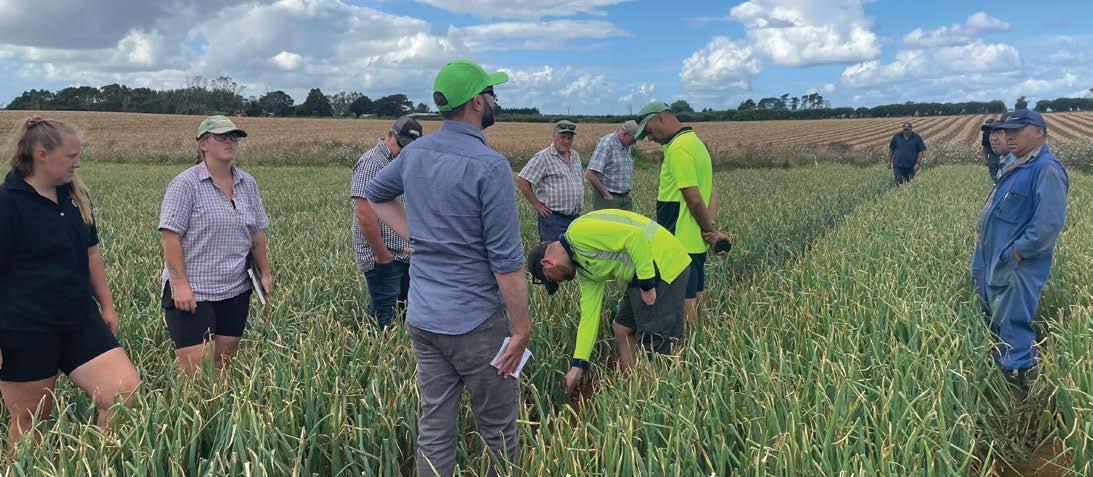
If you grow onions, you have likely seen the impacts of Stemphylium Leaf Blight (Stemphylium vesicarium) on your crop at some point over the last few seasons.
Stemphylium leaf blight has been found in all onion growing areas and has had varying impact on the crop, from complete crop loss to noticeable but non-limiting. Unfortunately, the more severe impacts from this disease are still causing significant issues, and therefore Onions NZ is implementing new projects to better understand this pathogen and how to best manage it in the field. This is part of the Sustainable Farming Fund Futures (SFFF) project Humble to Hero, co-funded by the Ministry for Primary Industries (MPI) and the onion industry.
Stemphylium leaf blight is a foliar disease in allium crops that can result in complete defoliation of the plant, compromise bulb quality and can make the plant more susceptible to other diseases that affect bulb quality. If infection occurs early enough in the development of the onion plants, this can result in a crop of small, unmarketable bulbs, or no bulbs at all. Infection starts as small yellow-tan water-soaked spots, which elongate into light brown lesions, finally turning dark brown or black as the pathogen produces a dense mass of spores. Eventually the entire leaf
becomes completely blighted, with rapid necrosis occurring, defoliation and early dying of the crop.
Onions NZ has utilised overseas experts to help us understand the impact and management of Stemphylium in other countries. Agronomist Andy Richardson from the United Kingdom spoke to growers in December about the importance of minimising agronomic stress on the crop, ensuring that plant health, water, nutrients, and so on were not limiting growth. Also, the importance of managing other pests and diseases to minimise ways for Stemphylium to enter the plant.
This project has highlighted how the onion industry can work together to tackle significant issues
Frank Hay from Cornell College of Agrisciences and Life Sciences, New York State, USA spoke to growers in January to highlight the risks of resistance developing in the Stemphylium population in response to fungicide application. Frank stressed that New Zealand needs to avoid the situation in New York state, where they can no longer get control from multiple different groups of fungicides.
The risk of fungicide resistance is a real threat.
Last season Onions NZ worked with Plant & Food Research to assess the fungicide sensitivity of some Stemphylium collected from the Pukekohe and Northern Waikato region, and the results were concerning. Because of this Onions NZ has scaled up this sensitivity screening to look at samples collected from Pukekohe, Matamata, Hawke’s Bay, Manawatu and Canterbury. To get as much information as possible, the samples collected will be tested against over a dozen fungicide active ingredients. This work will help to identify control strategies for Stemphylium but will also allow resistance management guidelines to be developed to preserve the effectiveness of fungicides. This is incredibly important for the onion industry, but the size and scale of the work makes this project a significant investment on behalf of the industry. Because of that Onions NZ reached out to the wider crop protection industry to help support this work, and we have been blown away by the generosity and support from agrichemical companies and distributors.
Onions NZ would like to thank the following businesses, which without their support this project would not be possible: Adria Crop Protection, AgriSource, Arxada, BASF, Bayer, Fruitfed Supplies, Horticentre Charitable Trust, Nufarm, Seed & Field Services Ltd (NZ), and Syngenta NZ.
Onions NZ would also like to thank the numerous growers, companies and individuals who collected and sent samples in for the sensitivity project. Without good quality samples the results from this work would be very limited.
Finally, Onions NZ would like to acknowledge Peter Wright from Plant & Food Research who is conducting the lab work for this project. Peter has spent many hours on this, especially when multiple samples arrived at once. Onions NZ appreciates Peter going above and beyond to ensure this work is completed to high quality and in a timely manner.
This project has highlighted how the onion industry can work together to tackle significant issues. Onions NZ looks forward to sharing the results with growers and the wider industry when they are available and taking big steps in the long-term integrated management of Stemphylium Leaf Blight.










In Hawke’s Bay, where a major water consent renewal process is underway, many growers have been informed that their water allocations are being cut back. As always when policies change, there are losers, but most should be able to manage nine years in ten if they use their allocation wisely. Well, at least in theory.
To maximise irrigation efficiency, there are two critical things to get right: knowing exactly how much to apply and when, and ensuring the irrigation system is applying the right amount as evenly as possible. We strongly recommend soil moisture monitoring to know how much and when. In this article, we’ll deal with irrigator performance and bucket testing – ensuring the irrigation system is applying the right amount evenly.
No irrigator is perfect and to manage well, we need to know both the depth it is applying and how evenly it covers the crop. And to know that, we need to measure it.
One way to determine depth applied is to divide the volume pumped by the area covered. You could work that out from your water meter and the paddock area, or by putting a bucket under the irrigator. [See the maths in the side panel.]
If your irrigator applied water perfectly evenly, that would be all you needed to do. But no irrigator is perfect, so we need to measure how evenly the water is applied. Is everything getting about the same or is there a lot of under and over watering? As a rule of thumb, we need a minimum of about 20 measurements to get a reliable estimate of average depth and evenness.
Different types of irrigation tend to apply more uniformly than others. Dripline or micro-sprinklers are typically best. Pivots, linear-moves and booms should be very good, but guns on a windy day are likely to be very poor. Spraylines can be good but are often very poor. The evenness makes a huge difference in the amount of water needed to adequately irrigate a crop, because it determines the amount of water that we ‘need to waste’ to get most of our crop adequately watered. If we want most of the crop to get at least the target depth, we need to apply more so that the under-watered areas get enough.
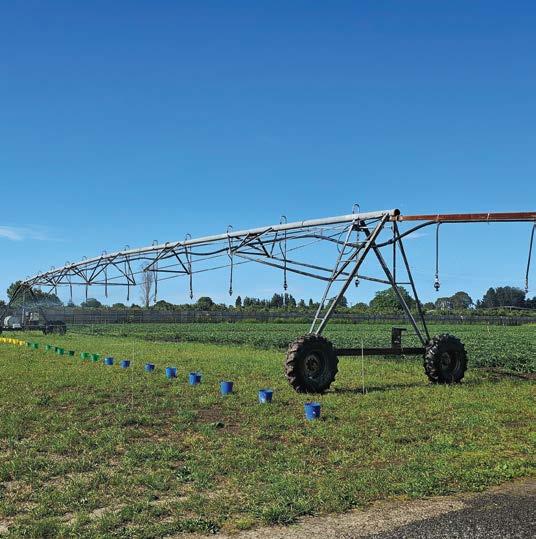
The measurement of the evenness of application we use is distribution uniformity (DU). It is calculated by comparing the average of the lowest quarter of depth measurements with the average of all the measurements. Then, dividing our target irrigation application depth by the DU tells us how much extra we need to apply so that three-quarters of the crop gets at least the target amount. The higher the DU, the less extra (wasted) water we need. [See the example in the side panel.]
About twenty years ago, we developed the ‘bucket test’ to help growers check their irrigators. It is included in many sectors’ best practice systems, is quick to do and it needs no special equipment. There are guides for checking all kinds of irrigation systems, and a downloadable PC app to do the maths and prepare a report for you.
We recently checked the linear-move irrigator at the LandWISE MicroFarm for the umpteenth time. It hasn’t been used for a couple of wet, cyclonic years, and we were surprised to see it putting much more water on in a couple of places (Figure 1). The wrong nozzles had been put back after an alternative technology demonstration. It only needed a simple fix to lift water use efficiency and crop quality.
The LandWISE online learning series prepared with support from the Ministry for Primary Industries’ Sustainable Food & Fibre Futures (SFFF) fund and the Vegetable Research and Innovation Board has a lot more information to guide irrigation management decisions and irrigator performance testing. The Irrigation Management course covers:
• Irrigation Efficiency
• Soil Water Concepts
• Distribution Uniformity
• Pre-Season Checks
• Assessing a Travelling Irrigator
• Soil Water Budgeting
• Irrigation Management
• Irrigation System Assessment


See www.landwise.org.nz/courses/irrigationmanagement. There are links to helpful resources including bucket test recording sheets and software downloads.
You do need to register (it is free), then you can work through a series of short courses and self-tests to check your understanding.
Depth Applied
Depth applied is the volume divided by the area covered.
m3 ÷ ha ÷ 10 = mm
If volume is in cubic metres and area is in hectares, divide your answer by ten to get the depth applied in millimetres.
L ÷ m2 = mm
The volume caught in a bucket (litres) ÷ bucket opening area (m2) = depth applied (mm).
Distribution Uniformity
Example: applying 30 mm of water to a 10 ha crop needs 3,000 m3 of allocation.
A DU = 0.90 means the depth applied in the least watered quarter of the crop is 90 percent of the average depth across the whole crop. If we want to apply 30 mm of irrigation, applying 30 ÷ 0.90 = 33.3 mm will ensure three-quarters of the crop gets at least our target of 30 mm (some will get more, and a small area will get a wee bit less). We’ll be using 330 m3 of extra allocation every time we irrigate.
If our machine has a DU = 0.70, we’ll need to apply an average of 42.9 mm so three-quarters of our crop will get at least the target 30 mm (some will get a lot more, some will get less and lose yield). And we will waste 960 m3 every time we irrigate a 10 ha paddock.
The 630 m3 extra waste could water another 2 ha if we lifted DU from 0.70 to 0.90.
Chart showing the measured application depths on the MicroFarm Linear. The high zones at each end show where incorrect sprinkler nozzles were refitted. The applied depth is very close to the target depth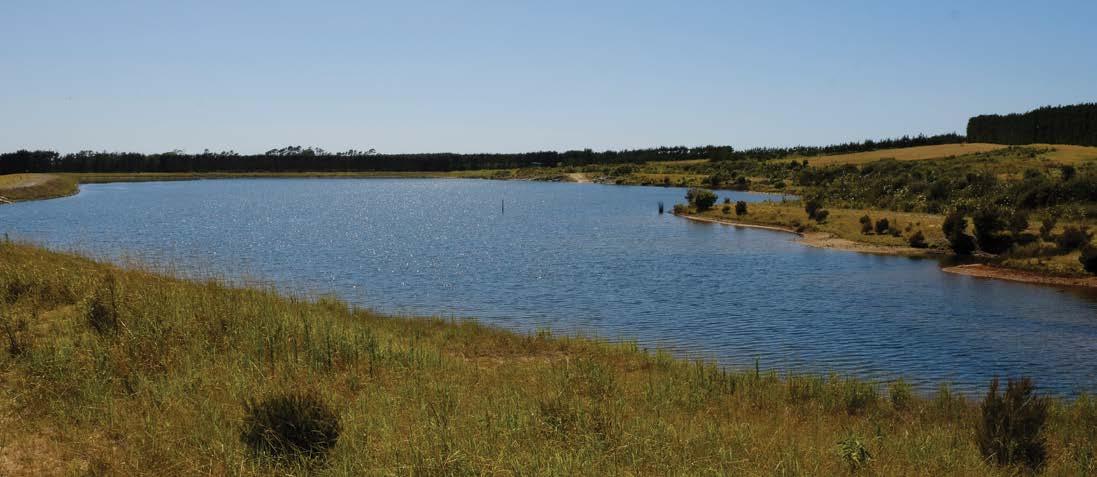
While horticultural crops can be grown without irrigation in some parts of New Zealand (and currently are, in some cases), access to a reliable irrigation water source provides insurance against crop loss in severe droughts, and confidence that crop quantity and quality can be managed consistently (although there are other factors that can still contribute).
In general, New Zealand has abundant water resources, but from an irrigation perspective the water is often in the wrong place at the wrong time. Water storage is a vital tool to correct the mismatch between supply and demand.
For new developments requiring external capital, investment in a reliable water supply can help to unlock much greater investment in the development as a whole. While there is potentially irrigable land available in regions suitable for development of new high-value horticulture, in many cases the “easy” water is already allocated, and new developments may need to rely on less reliable sources with higher cease-take flows.
Over time, changes in climate and the regulatory environment are likely to result in less reliable access to water for existing water users: new regional plans or renewal of resource consents may result in changes to allocation rules.
Groundwater, traditionally thought of as a completely reliable water source (if wells are deep enough), may become subject to low-flow restrictions in future as more thought is focussed on the hydrological system as a whole. The importance of water storage development for highvalue horticulture has been a consistent message from former and current governments. The Ministry for Primary Industries’ Fit for a Better World roadmap for the primary sector aims to support development of water storage solutions that enable productivity increases (i.e. greater revenue per hectare, or per m3 of water used for irrigation) and build climate resilience. As the value of the production supported by irrigation increases, so too does the potential loss from water supply shortages. Therefore, it’s critical to get the fundamental design of a storage-based water supply system right.
Getting the volume of water storage right is the first step. This should come before decisions are made about the location or type of storage. Correctly sizing storage requires an understanding of:
• the available water supply, and how it varies over time (month to month and year to year),
• the water demand profile of the existing or proposed crop(s),
• the supply reliability requirements.
Determining the required supply reliability, or security of supply, involves understanding what water supply deficits are acceptable, in terms of frequency, duration, timing and severity. There is no one-size-fits-all answer, and a single percentage metric doesn’t tell the full story about reliability. It ultimately comes down to risk appetite. Horticulture doesn’t have the option of de-stocking or buying in supplementary feed as is possible in a livestockbased farm system, which elevates the importance of a reliable water supply.
Scenario analysis using models that simulate water supply, demand and storage volume and refill capacity using historical climate and river flow records can tell us how much water would have been required to provide a particular level of supply reliability in historic dry years. Climate change projections can be factored into this type of modelling; for larger developments with a long design life, or where inter-generational planning is part of the picture, it is important to factor in demands and water availability under future climates.
Commissioning a modelling study to determine the size an on-farm storage pond may feel like an unnecessary expense, but when the consequences of not having water at critical points in the growing season are high, is it wise to rely on a rule of thumb for sizing storage, particularly in the


context of a changing climate? Conversely, a storage sized on rule of thumb could be oversized, resulting in unnecessary capital and maintenance expenses and (in the case of on-farm storage) too much land being taken out of production.
Broadly speaking, there are two options for water storage: community storage, where the storage and associated infrastructure and resource consents are owned by a company (or similar ownership structure) and water users are shareholders in the water supply entity, or on-farm storage where individuals own and operate the infrastructure.

Grow yield with the best spinach:
Onyx: autumn, semi savoy, Pe:1-19
Limestone: autumn, semi savoy, Pe:1-18
Quartz: autumn into winter, smooth, Pe:1-19
Skarne: autumn into winter, semi savoy, Pe:1-19
Tectonite: winter, Oriental, Pe:1-18
PV 1582: winter, Oriental, Pe:1-15,17,19
Unique and stunning, brilliant dark green gem, suitable for hydro and outdoor production. Good internal quality. Late filling with smooth glossy leaves that are easy to separate. High vigour, compact shape, height 15cm. HR: BL:1-32, 34-36, Nr:0, LNSV, For:1

Excellent spring harvest crisphead variety, suited to mid Sept – mid Dec harvest dependent on region. Dark green well wrapped head. Clean butt and nice internal colour. Flat round shape. Resistance to BL:1-36 and Nasonovia.

Flexi Tanks NZ’s bladder storage is found throughout New Zealand, such as these (1 million litres each) at a Tolaga Bay covered crop operation. Flexi Tanks NZ’s Anton Meier says the installation takes just hours to complete. The tanks, manufactured by France’s Labaronne since 1959, have proven extremely tough and long-lasting. Photo by Flexi Tanks NZ
Community schemes typically have a lower cost per m3 of water stored or hectare irrigated due to economies of scale. Schemes don’t need to service tens of thousands of hectares to be viable: for high-value crops there can be worthwhile economies of scale for a few hundred hectares spread over multiple properties.
Establishing community water supply schemes is not without difficulty though, even on a relatively small scale. Broad community support is required from water users and other partners. Obtaining resource consents is more difficult: larger water takes and storage sites attract more scrutiny in the consenting process. The new government has introduced legislation to fast-track consenting for major infrastructure projects, and funding for regional infrastructure development. It remains to be seen where all this lands in terms of rural water infrastructure. Water storage in Northland was consented under a post-covid consenting fast-track process, and the provincial growth fund supported water storage projects under the previous government, so there is precedent.
Once established, operation and maintenance of a community scheme is taken care of by the scheme company. This includes resource consent and dam safety compliance, which have the potential to be a significant headache if the infrastructure is owned by individuals.
While in the past schemes tended to provide water on a “use it or lose it” roster basis, it is more common now for water to be ordered on demand via a web portal. Depending on the scheme’s share structure and water charging method, it may be possible for individual water users to determine their own level of reliability from the scheme (within the constraints of the scheme’s overall storage volume and resource consents).
Other benefits of community schemes include the potential to provide water for non-irrigation uses (e.g. potable supply, firefighting), environmental flow enhancements, and recreation. It may be possible to store water at higher elevations, allowing it to be delivered under pressure. Suitable sites for community-scale storage can be a scarce resource in some areas though, once engineering and geological constraints are factored in.
On-farm storage puts all decisions and responsibilities related to water supply in the hands of the landowner. In most cases it will be easier to obtain the relevant consents and get storage constructed without the need for input from multiple stakeholders. On-farm storage can be sized to the requirements of the crop(s) being grown and the individual grower’s risk appetite. Typically, it is less efficient in terms of both the capital cost and the area of land required per m3 of water stored. Unless there is suitable unproductive land (such as a gully that can be dammed), on-

farm storage normally requires taking land out of production. Refill capacity can be a constraint, in terms of both consenting and infrastructure. After using stored water, the ideal situation is to be able to refill storage immediately, so that it’s ready to go again when needed.
A mix of community scheme and on-farm storage is potentially an attractive option that provides greater flexibility. This combination can provide a baseline level of reliability, potentially lowering the bar for investment in the scheme, while allowing individual growers to tailor their overall water supply security to their own needs or risk appetite.
For growers contemplating on-farm storage, there are a range of potential options. Ponds are often formed by excavating material from the pond site and using it to form embankments. This has the advantage of utilising space below the natural ground level to store water, but the depth to the water table (and how this varies over

time) may be a constraint. To avoid losing water to ground, a synthetic liner may be required, depending on the suitability as a lining layer of natural materials available in the area. New dam safety regulations commence in May this year, applicable for dams 4 m or higher storing more than 20,000 m3, or 1 m or higher storing more than 40,000 m3. For some owners of storage ponds, this will create additional costs and workload to ensure compliance.
Floating solar panels on water storage ponds is an idea that has gained some traction recently. This can reduce evaporative losses and provide shading that helps prevent weed and algae growth. It provides the opportunity to use the pond’s surface area to generate power for on-farm use and / or export to the grid, which can partly offset the lost production from the pond area. The efficiency of the solar panels may be greater than panels mounted on land or buildings due to the cooling effect of the water mass beneath.
"I RECOMMEND IT TO EVERYONE, IT'S THE CLEANEST
THAT I’VE GROWN WITH IN MY YEARS. I’VE HAD MY BEST SEASON OF PRODUCTION." KAIPAKI BERRIES,
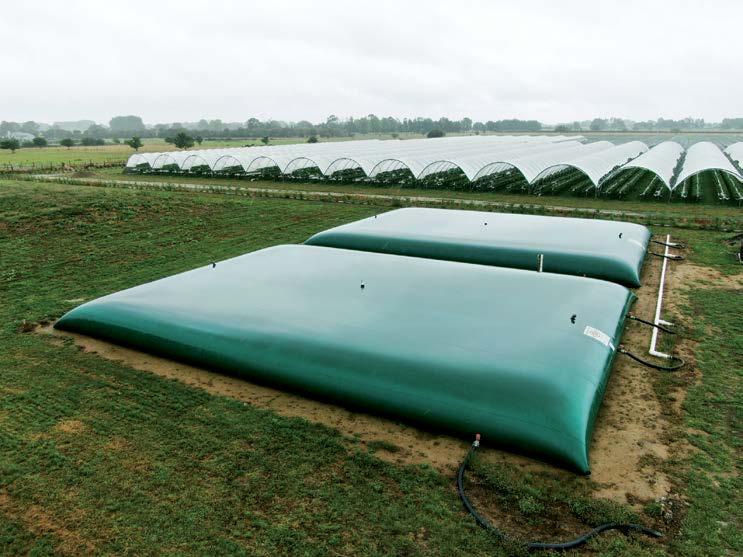

Canterbury has more than 60 percent of the country’s irrigated farm land, mostly for dairy. Highlighted in red are the large community storage schemes on the Rangitata River on the left and on-farm ponds. New Zealand has more than 3000 on-farm ponds according to an Irrigation NZ estimate. Image courtesy of Aqualinc
Above-ground tanks may be a viable option for smaller irrigated areas or where there are space constraints, as there can be some flexibility with layout. Tanks require a flat, stable area for installation, and some larger options have specific foundation design requirements. Off-the-shelf plastic tanks typically have a maximum size of 30 m3 per tank (which doesn’t go far by itself in terms of improving supply reliability), but multiple tanks can be connected as part of a storage solution and the total storage can be scaled up relatively easily by adding additional tanks. Larger tanks requiring more specific design and on-site installation can hold up to 6000 m3. Key advantages of using tanks for water storage include reduced evaporative losses and improved water quality: they are less prone to algal growth and fouling by wildlife (although larger tanks may not include a roof / cover in their standard design and pricing).
Flexible bladders are also potentially a cost-effective solution for smaller volumes, holding up to 2000 m3
Call our experts 0800 130 905
www.irrigationexpress.co.nz
each. These are easily installed and require minimal site preparation. Bladders have similar advantages to tanks in terms of evaporative losses and water quality. They are potentially vulnerable to damage through punctures and tears.
Managed aquifer recharge (MAR) and aquifer storage and recovery (ASR) have received some attention as alternatives to surface storage. These shouldn’t be written off as part of a catchment-scale solution, but their applicability is highly location-specific and they need a thorough understanding of the groundwater system and how it interacts with surface water, which is lacking in many areas.
Many parts of New Zealand have experienced extremely dry conditions this summer, which are now extending into autumn. This is likely to be focussing people’s thinking on options for more resilient water supplies. Storage will be an attractive option in many cases for improving and future-proofing water supply security, but it’s important to not rush into it without careful investigation and design. Although some storage is always going to be better than none, the level of investment required justifies the investigation effort to get it right, and you’ll sleep better at night knowing that water is likely to be there when you need it.


It is truly remarkable how collaborative efforts among growers can lead to innovative solutions to horticultural challenges. In New Zealand, the primary sector is actively transitioning towards more sustainable production practices, which require evidence-based decision systems and support. With regard to nitrogen flowing through an extremely complex and ever-changing vegetable growing system, a significant hurdle lies in the absence of a universally accepted method for measuring, monitoring and reporting. And this is where the idea for the Sustainable Vegetable Systems was created, with Potatoes NZ leading the project and recruiting key partners.
The Sustainable Vegetable Systems project started in late 2019 and acknowledges the scarcity of data on vegetable nitrogen flows, particularly within rotational or leased land crop systems. To address this gap, the SVS project brought together key vegetable groups to develop a decision support tool using an integrated data set based on real world practices that are robust, trusted and reflect industry practice. By consolidating data from various sources and stakeholders, the project endeavoured to provide valuable insights into vegetable nitrogen optimisation and support the development of sustainable production practices.
Government investment in this project has enabled the involvement of key industry players including Potatoes NZ, Horticulture New Zealand, and the Vegetable Research & Innovation Board, including Vegetables NZ, Onions NZ, Process Vegetables NZ, and NZ Buttercup Squash Council to expand initial research efforts in several crucial areas, leading to greater impact and applicability across the sector.
Key aspects of this project expansion include:
Increased regions within New Zealand for field trials
Increased grower engagement and knowledge extension
Expanded availability of tools and platforms across the sectors
Increased data to inform current or new models
This broader impact underscores the significance of government investment in fostering sustainable agricultural practices and supporting the growth of the vegetable production sector.
Achieving environmentally sustainable vegetable production involves managing inputs to meet economic crop production needs, while reducing environmental impact. Optimising inputs is complex due to varying soil, environmental and crop conditions. For instance, crops grown on soils with high potentially mineralisable nitrogen, or long rotations, require less nitrogen fertiliser compared to other soils or systems.
To reduce environmental impact and optimise production, a sophisticated approach to crop management is necessary, considering the variability within fields, from field to field and year to year. Current systems often lack the ability to account for factors like land leasing and are not calibrated for vegetable production. More validation data and controlled experiments were needed, and continue to be needed to inform and develop accurate models tailored to the vegetable industry, ultimately promoting sustainable crop management strategies and building grower trust.
Trufitt : Potatoes NZ chief executiveThe Sustainable Vegetable Systems (SVS) project is a four-year multi-stream nationwide project that is delivering a decision support tool. Project outcomes provided data that has:
• informed industry on existing management practices,
• further equipped growers with a tool and capabilities to optimise nitrogen management, lowering production and environmental risks,
• supported the transition to a more sustainable future and
• maintained growers’ licence to operate.
The SVS project is currently in the last year:
WORKSTREAM 1
Controlled experiments
Through experimental field trials conducted in Hawke’s Bay and Lincoln, data on nitrogen flows was collected. The ultimate goal of this workstream was to establish a research framework that can be applied to vegetable crops and to other crop production systems.
WORKSTREAM 2
Regional on farm monitoring
Regional monitoring across various commercial crops was used to collect soil and crop nitrogen data that was used to ground truth the research and modelling.
WORKSTREAM 3
Farmer facing tool
This Workstream developed the SVS Decision Support Tool. At its heart the SVS Tool provides a platform for informed discussion and decision making. By integrating soil testing, measured numbers override modelled predictions as the crop grows.
WORKSTREAM 4
Developing a change landscape
Ensuring a tangible and enduring impact by focusing on the effective utilisation of the SVS Tool and sharing knowledge and data related to mitigation strategies with growers.
Accurate monitoring of soil nutrients and water will empower growers to make informed decisions regarding fertiliser management, thereby reducing both economic and environmental risks. Ultimately, the project’s goal is to facilitate the transition of the vegetable industry and growers towards a more sustainable future, while providing the evidence necessary to maintain social and regulatory licenses to operate.
This project aims to harness current technology and knowledge in crop modelling, exploring innovative tools for real-time data acquisition. These tools could potentially empower growers to make more sustainable decisions in response to changing environmental conditions, avoiding delayed responses.
With a clear understanding of industry scope and community views, the project can effectively engage with key stakeholders like NZGAP (Good Agricultural Practice) and other groups to drive change. Various approaches are being employed to support industry transformation while respecting growers’ needs, behaviours and knowledge uptake methods, including the use of workshops and one-on-one support. Ultimately, the project aims to enhance understanding of nitrogen management, thereby enabling growers to improve nutrient use efficiency through the adoption of best management practices based on sound scientific knowledge.






Andrew Barber and Henry Stenning : Agrilink NZ
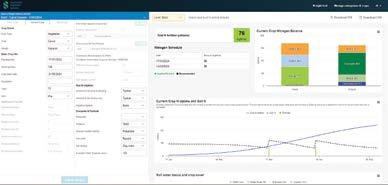
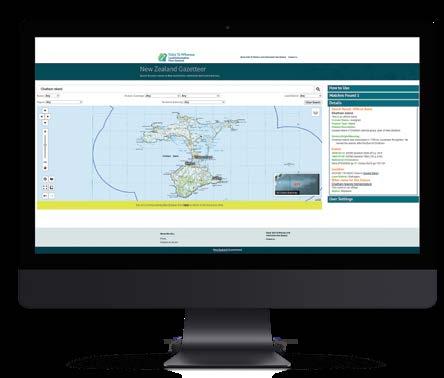
A beta version of the Sustainable Vegetables Systems (SVS) Tool is available to be used now, and we welcome your feedback to the project manager Andrew Barber, andrew@agrilink.co.nz. The SVS Tool (beta version) can now be accessed at www.svstool.co.nz
• All crops in the Workstream 2 regional trial sites have been harvested, with data currently being analysed and used to ground truth the SVS model outputs. Early results show good correlation between the SVS Tool and in-field monitoring.
• Work continues on improving the model underlying the SVS Tool. This includes new and updated crop coefficients and the development and incorporation of crop residue mineralisation and nitrogen loss sub-models.
• A series of upcoming workshops are to be held from March to May in the following regions: Nelson (19 March), Pukekohe (10 April), Hawke’s Bay (11 April), Christchurch (16 April), Invercargill (17 April), Ohakune (30 April), Manawatu (1 May), and Gisborne (9 May). These workshops will demonstrate the SVS Tool and discuss how it integrates with soil nitrogen testing and within the nutrient management decision making process.


The SVS Tool provides nitrogen application guidance based primarily on predicted crop nitrogen uptake, balanced by an assortment of other inputs and outputs. The key coefficients determining predicted nitrogen uptake by crop are yield, harvest stage and nitrogen content. Plant & Food Research have been analysing the data collected from the intensive field trials conducted in Hawke’s Bay and Canterbury to determine the values for these coefficients for each crop.
Cultivar-specific coefficients have also been developed for some crops (e.g., potatoes) with greater levels of variety specific variation.
Other coefficients analysed included dry matter percentage and harvest index (the partitioning of nitrogen between the marketable crop and residue), with the results of these analyses being used as default values within the SVS model.
Significant progress has been made with model development over the past several months, with the incorporation of new coefficients and sub-models, as well as testing and calibration using data from Workstreams 1 and 2.
Soil nitrogen predictions and utilisation of soil tests have been improved through connecting the tool to 46 climate stations around New Zealand. This has substantially increased the accuracy of nitrogen mineralisation predictions as well as the outputs from the drainage sub-model.
A sub-model that has been developed, and is currently being incorporated into the tool, is for crop residue mineralisation. This model predicts nitrogen mineralisation from the Carbon: Nitrogen ratio of crop residues, influenced by soil temperature and moisture – similar to the soil organic matter mineralisation. High Carbon: Nitrogen ratio crops generally show less mineralisation than crops with lower ratios. Indeed, high Carbon: Nitrogen arable crops such as wheat and maize often show an immobilisation effect, where mineral nitrogen in the soil decreases following residue incorporation. In contrast, vegetable crops such as brassicas can release a significant quantity of mineralised nitrogen following residue incorporation.
To ensure that the guidance provided by the SVS Tool corresponds well with observed measurements taken from real growing operations, a validation system has been set up to test model outputs against observed readings from Workstream 2 monitoring around the country.
Early indications from this testing are that the model outputs correlate well with in-field observations, though if significant discrepancies are to occur as testing continues these will be investigated, and any necessary adjustments made to the model. Other data sets that will be used to calibrate the model:
• Workstream 1 field trial data,
• additional crop coefficient data for pea and potato varieties, and
• data from the Sustainable Farming Fund project ‘Mineralisable N to improve on-farm management.’



This testing is currently at an early stage, however in a future update article we anticipate being able to report on the results of this validation, and any changes made to the model in response to the testing programme.
In anticipation of programme completion in June, a series of workshops is about to get underway around the country, demonstrating the SVS Tool and promoting its place on farms as a decision support tool. The following workshops have been planned from March through May:
Ohakune
30 April at the Powderkeg
Gisborne
Pukekohe
10 April at the PIA Events Centre
Manawatu
1 May at the Distinction Coachman Hotel
9 May at the Bushmere Arms
Hawke’s Bay
11 April at the Havelock North Function Centre
Christchurch
16 April at the Hotel Ashburton
Invercargill
17 April at the Ascot Park Hotel
Continued user-testing, as well as feedback from the upcoming workshops, will lead to further improvements to the user-interface within the SVS Tool. The crop and scenario management window is being redesigned, which will improve the experience for users with large numbers of paddocks and crops, and simplify the scenario creation, selection and update process for all users.
For any questions or comments on the Sustainable Vegetable Systems programme, please email the programme manager Andrew Barber andrew@agrilink.co.nz






Antony Heywood : Vegetables New Zealand Inc. general manager
It’s been great to have had the opportunity to talk directly with growers over the past few weeks, with more opportunities to come over the next few weeks as the Vegetable Research Roadshows take place across the country. Vegetables NZ has also been part of Horticulture New Zealand’s engagement with growers in the lead-up to voting on the Commodity Levies in mid-May this year.
Back in early 2020, the Vegetables NZ Board made the decision to step up its activity under the impetus of ‘getting things done’. Since then, I am very happy with the progress we have made in research, development & extension, and advocacy. I am also proud of the difference we made –working in partnership with other product groups, HortNZ and government agencies – during Covid-19, and last year following the aftermath of Cyclone Gabrielle.
Looking ahead, Vegetables NZ wants to get closer to growers, particularly through Crop Advisory Groups and District Associations. We also want to take more control of the future of vegetable growing in New Zealand, working in partnership with Māori, HortNZ and central and regional government.
The coalition government is committed to developing a pathway to consent for vegetable growers within its first term. We believe a National Environmental Standard is the way to go, however, over the coming weeks we will be firming up our thinking and going out to growers for their feedback, before we move forward.
Our second set of integrated pest management workshops are underway at Cronin Road in Pukekohe. The first workshops were on lettuce and the second ones are on broccoli. To maximise the number who can attend, growers have been able to join in person and online. The workshops are being run in partnership with A Lighter Touch.
Partnerships like these enable us to make the best use of growers’ levy money as well as available government funding.
On 1 March, we launched Add One More Vegetable, which is a partnership between vegetables.co.nz and 5+ A Day to increase vegetable consumption and encourage everyone to put more vegetables on the plate. 5+ A Day has integrated Add One More Vegetable into its annual seasonal campaign. From a vegetables.co.nz standpoint, Add One More Vegetable complements the work done in schools to teach children – and their parents – good habits when it comes to meal preparation and the use of vegetables.
Media interest in the price of vegetables seems to have waned, now year-on-year and month-on-month, prices have dropped. This is not good news for growers while inflation is still high in other parts of the economy, and the minimum wage goes up yet again on 1 April 2024 to $23.15 per hour – an increase of 45 cents per hour from the current hourly rate of $22.70.
The horticulture sector has pointed out to the new government that such an increase is not helpful. However, feedback has been that they have taken a compromise position.
We have also been part of discussions with the government on Resource Management Act reform. It is good to see this work underway, however, there is an awful lot of work to do in this area, and in the freshwater management area. Key to making progress – and ensuring vegetable growing in New Zealand has a future – is a pathway to consent and a set of fit-for-purpose requirements that make use of existing assurance schemes.
We will keep you posted, but in the meantime if you have any feedback, please email me: antony.heywood@freshvegetables.co.nz
or visit our website to join one of the Vegetable Research Roadshows www.freshvegetables.co.nz


Process Vegetables NZ held a board meeting with a difference in March, with a field and factory tour around Hawke’s Bay.
Process Vegetables NZ business manager Matt Thorn took the wheel of a minibus as a group of 16 growers from around the country, together with processor representatives, got to see fellow growers’ farms, tour the McCain Foods factory in Hastings and visit Tasman Harvesting in Hastings.
“Our mission was to get members out in the field rather than sitting round a board table,” says Matt. “It was really good to see growers from all around the country together, in the field, talking and sharing their ideas on crop rotations, nutrient management and getting better production.
“We also had processor representatives from Heinz Wattie’s, McCain Foods and Talley’s Foods along. The growers were really interested to see the farms in different locations, the various farming systems in different areas, get to look around a processing plant and learn more about the harvesting machinery.”
A substantial part of the Process Vegetables NZ budget is in research for process vegetables, including A Lighter Touch Programme, the major Sustainable Food & Fibres Futures collaboration of 15 product groups.
“We also provided an update about the work we are doing on process vegetables growers’ behalf, including the A Lighter Touch programme,” says Matt.
It includes a major extension programme focused on the implementation of agroecological crop protection through the development of specific extension tools, model farms and focus groups to ensure grower uptake of new crop protection practices and integration into everyday practice.
“Among of the major aspects of the programme for us are the trials being undertaken in Canterbury around biological sprays for peas and beans,” says Matt. “So we talked about that work. Some chemicals are expected to be phased out, so there is a need for the industry to find ‘soft biologicals’ that can be used in the sector – that is very important for our members.”

The farm tours included a visit to grower Hugh Ritchie at the 2050ha Drumpeel Farms at Ōtāne to see the progress that has been made after the property was severely damaged when the Waipawa River broke its banks during Cyclone Gabrielle.
“We saw the huge amount of work that has gone into moving soil around, contouring, the new drainage and fencing that has been installed and Hugh’s crops, which were looking fantastic,” says Matt.
The final stop was at Tasman Harvesting where the group learned about the machines the company uses to harvest peas and beans throughout the Hawke’s Bay and Manawatu for McCain’s Hastings factory.
It operates a modern fleet of six Ploeger Pea Harvesters and three John Deere tractors with high lift trailers for the peas harvest and two Ploeger Bean Harvesters for the bean harvest in February and March.
“People really enjoyed getting into a shed with one of the huge harvesting machines, that can literally operate 24/7 for three months. We managed to pack a lot into the day and cover a lot of topics.”
Contact Process Vegetables NZ business manager Matt Thorn:matt.thorn@hortnz.co.nz
Matt Thorn : Process Vegetables NZ business manager

Dinah Cohen : TomatoesNZ business manager
A very rewarding part of my job is getting out to meet growers. It is only by seeing firsthand and hearing directly about the problems you are facing, that I can advocate on the issues that are important to you. So I am looking forward to meeting those of you that can make it to the following events:
Crop resistance and IPM
Wednesday 10 April @ 3pm Pukekohe
Vegetables NZ and Vegetable Research & Innovation (VR&I) research and development workshop giving updates on a range of projects focusing on crop resistance and integrated pest management programmes, including an update on the TomatoesNZ project using beneficial insects to help control whitefly, tomato-potato psyllid (TPP) and other common greenhouse pests.
RSVP and to check dates in other regions: www.freshvegetables.co.nz/news-and-events/events/ vegetable-research-roadshow-2024-register-now
Reducing your energy bill
Thursday 23 May @ 12pm Pukekohe
Monday 27 May @ 12pm Christchurch
TomatoesNZ and Vegetables NZ invite all covered crop growers to attend an energy workshop on ‘Reducing your energy bill’. Both workshops include presentations on tools developed for growers to help reduce energy use in greenhouses. There will also be a visit to Zealandia nursery to see some of the energy reducing tools that they operate and the chance to ask questions.
RSVP indicating which event you would like to attend by emailing ellery.peters@freshvegetables.co.nz
TomatoesNZ AGM
Thursday 8 August @ 12–5pm Auckland (with travel subsidy available)
TomatoesNZ is pleased to invite all growers to their mini conference and AGM. An exciting line-up of discussion panels and presenters will be part of this day. There is a travel subsidy available for TNZ growers outside of the Auckland region. Please contact dinah.cohen@tomatoesnz.co.nz as soon as possible for more information and to make use of cheaper airfares.
If you cannot get to these events, please feel free to contact me to arrange a chat dinah.cohen@tomatoesnz.co.nz
TomatoesNZ / Bioforce / A Lighter Touch project
Some of the key messaging coming out of the TomatoesNZ / Bioforce / A Lighter Touch project on beneficial insects includes:
• Talk to your beneficial insect supplier as soon as you have a date for planting to ensure they have supply for the good bugs that you want, when you want them.
• Ask the nursery supplying your plants not to use chemicals. This will affect the ability of your beneficial insects to survive.
• For beneficial insects to survive, they need some pests to eat, which requires a change of mindset if you think zero pests is the desirable outcome. Maintaining a balance between enough pests to feed the beneficial insects and too many pests to cause crop damage is really important and something you should talk to your supplier about.
• Chemical use will likely kill your beneficial pests and there will always be a withholding period before they can be reintroduced. Talk to your supplier BEFORE you use sprays to ensure you maintain a healthy population of beneficial insects while also keeping pests below the desirable threshold.
For a further update on this TomatoesNZ project, please see pages 32

Korean growers’ workshop
Finally, TomatoesNZ wants to thank Horticentre for organising a special workshop last month for Korean growers, simultaneously translated by TomatoesNZ board director Jiny (Junguen) Kim. The topics covered were hygiene, nutrition and disease and the feedback from the
growers has been really positive, with everyone being able to take their learnings back to their greenhouses and immediately put their new knowledge to good use. Horticentre willingly gave their time and knowledge for free and TomatoesNZ is extremely grateful for this.
 A Korean growers’ workshop organised by Horticentre focused on greenhouse hygiene, nutrition and disease
A Korean growers’ workshop organised by Horticentre focused on greenhouse hygiene, nutrition and disease



The Humble to Hero programme is a Sustainable Food & Fibre Futures (SFFF) partnership between the onion sector and the Ministry for Primary Industries (MPI). Established to transform the onion industry, this programme operates with a six-year vision, aiming to enhance the reputation of New Zealand onions and increase export revenues through strategic collaborations and projects.
Year 3 of the programme commenced in July last year with market access, assurance and value adding projects underway. Below is an update from the programme in Year 3 based on the three themes and categories of work.
Under this theme, projects are geared towards identifying potential new markets and overcoming obstacles hindering the export of New Zealand onions. Encouraging progress has been achieved:
1. An exporters’ delegation was facilitated to China this quarter to advocate for market access. During this trip a Memorandum of Understanding (MoU) was successfully signed to enhance trade, there were meetings with the New Zealand Ambassador, and constructive engagement with Chinese counterparts and New Zealand Chinabased colleagues.
2. Engagements in the market access space with Indonesia continue, and a market visit was conducted to reestablish connections with the market and advance the cooperation agreement with the Indonesian government.
3. New market intelligence work for India has been scoped and scheduled to be completed before June 2024.
4. Trial shipments are being scoped for the 2023–24 export season. Trial shipments allow onion exporters to gain valuable insights that can support increased trade in an untested market.
Kazi Talaska : Onions NZ project coordinator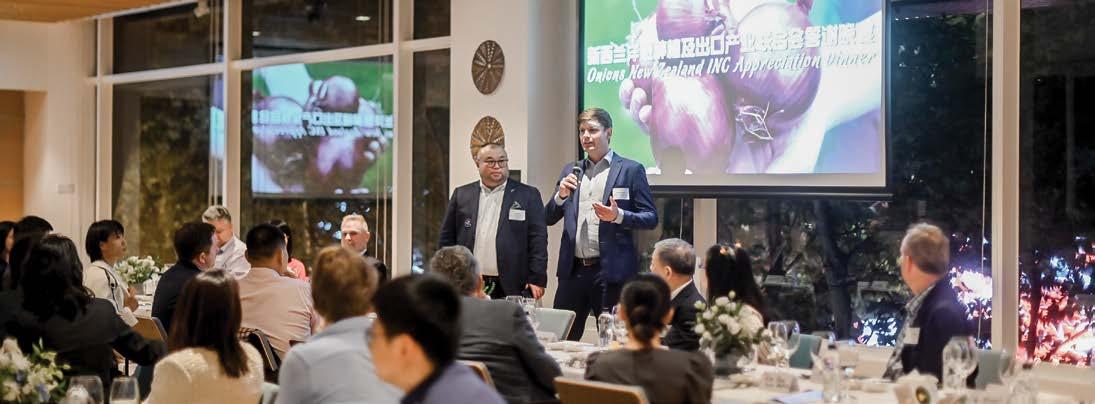
This theme focuses on implementing assurance programmes and information systems to enhance value.
Progress has been noted in the following areas:
1. The onions residue programme is set up to continue this season, with residue tests for growers well underway to support data and market assurances.
2. Continued engagement with food safety requirements across the MPI and the sector.
3. Development of tools for sustainability benchmarking, particularly in calculating greenhouse gas emissions. A tool has been developed and is being tested by growers.
4. Ongoing trials related to sustainability on farms, focusing on pest and disease control and nutrition, with preliminary findings discussed in field events over December and January this season.
This theme concentrates on enhancing industry value and developing the New Zealand onion brand.
Progress includes:
1. Continuation of phytochemical analysis to explore potential health claims using collected data, with further engagements planned with the MPI and Plant & Food Research.
2. New season trials underway for shipping best practice, looking to develop guidance for exporters at the end of this year on the optimal shipping container temperature and humidity settings for the best quality product on arrival.
3. Launch of the NZ onion story website, with campaign activities for 2023–24 underway. Testing of campaigns in overseas markets will also begin in the coming months.
The planning for the next project year will start over the next few months. Onions NZ will work closely with exporter and grower steering groups to ensure investments and projects planned for next year are fitted to industry ambitions.
Humble to Hero long term goals revolve around increasing the value of the sector, opening new valuable markets, and improving the reputation of the sector. The success of the programme is reflected by continued industry engagement and support. Please get in touch with Onions NZ to learn more about the programme and get involved.

For more information, contact: Kazi.Talaska@onionsnz.com
Visit newzealandonions.com and see the Onions NZ YouTube channel for the latest resources developed to promote the onion sector.


 An exporters’ delegation was facilitated to China to advocate for market access. A Memorandum of Understanding (MoU) was successfully signed to enhance trade
An exporters’ delegation was facilitated to China to advocate for market access. A Memorandum of Understanding (MoU) was successfully signed to enhance trade


Vanessa Winning : Irrigation NZ chief executive
Just over five percent of New Zealand’s agricultural land is irrigated, meaning the vast majority of pastural land (in particular) is reliant on natural weather patterns and has little resilience to a changing climate.
This makes it very difficult for farmers and growers to invest in new horticulture projects, as without water at the right time in the growing cycle, production is at risk. And while the ability to utilise irrigation grew in the early 2000s mainly due to new technology and improved water efficiency, it has been very difficult to get new irrigation storage projects underway in the past nine years.
This is due to poor understanding of what the water will be used for, investment for long term intergenerational assets being difficult to access, and regulatory restrictions regionally and nationally. These impediments have left New Zealand food growers vulnerable to a changing climate and have removed choices for land use.
Just two large water storage projects have come to fruition in the past six years.
With Waimea Dam (see page 12), the pay-off for the region is immediate. Not only are the vegetable and fruit growers ensured they have the water they need at the right time of the growing cycle, they are removing their reliance on ground water, insulating the township from forest fires, and providing reliable drinking water, all while improving the flow of the river.
Te Tai Tokerau water project (see NZGrower March 2024) is about halfway through to completion. Ultimately the idea is to link the Northland schemes across the area to provide reliable water for what could be a thriving food bowl, and provide a much-needed economic boost and jobs for locals. Water is the enabler.
Over the past 12 months the importance of the water storage issue and its impact on our ability to grow food has started to pick up steam again.

During the election and since, we have seen more stories and emphasis on how we do this better, and we are starting to see more enabling legislation to support development. With more certainty we will get more investment and growers trying different crops and developing land for additional uses. The flow on is jobs, supporting infrastructure, drinking water and community recreation facilities. Not only can these sites support drying conditions but they also help during floods and weather events. The frustration is that New Zealand gets enough water for all of us to thrive, but we don’t always capture and store it for those days we most need it. If we want to see a doubling in our horticulture economy, we will need to invest in more storage and capture of water and be smarter about the whole of community benefits it can provide.
IrrigationNZ represents irrigation schemes, individual irrigators, irrigator user groups, and the irrigation service industry. www.irrigationnz.co.nz
From right: Vanessa Winning visiting Te Tai Tokerau water storage construction in Northland with MP for Taranaki-King Country Barbara Kuriger and former Foreign Minister and Chair of Te Tai Tokerau Water Trust Murray McCullyUnderstanding a better approach to biosecurity risk management: Six primary industry sector groups and Biosecurity NZ, under the Government Industry Agreement for Biosecurity Readiness and Response (GIA), are putting Onside’s traceability technology to the test.
What is Onside?
Onside is a rural management app that simplifies compliance and makes health & safety and biosecurity easy on the go. Unlike other solutions, Onside is appbased and works offline, so it’s actually used by people on rural properties.
What are GIA and Onside doing together?
Biosecurity New Zealand, New Zealand Avocado, Kiwifruit Vine Health, New Zealand Apples and Pears, Aquaculture New Zealand, New Zealand Pork, and New Zealand Winegrowers have signed a memorandum of understanding with Onside to trial their biosecurity traceability technology. As part of the six-month trial, growers and farmers can use extra functionality in Onside for free to capture movements on and off their properties. It builds a networked view of people and biosecurity risk items moving between properties. The participating industries can access an anonymised view of their industry network to enable rapid tracing should a biosecurity incursion be detected.
Brad Siebert, CEO, NZ Avocado says “The faster we can map and contain pest outbreaks, the lower the response costs to industry.”
Onside and Kiwifruit Vine Health (KVH) have been partnered for over 18 months, engaging kiwifruit growers to adopt biosecurity measures and automate day-to-day operations with Onside’s mobile app. More than 740 kiwifruit orchards are recording biosecurity movements in Onside.
Leanne Stewart, CEO, KVH says; “Being able to take action quickly can be the difference in saving orchards and livelihoods.”
Onside helps rural businesses to overcome rural safety and biosecurity compliance challenges.
Manually collecting and sharing safety compliance data is often inaccurate, and typically paper-based.

With Onside’s mobile app, you can see exactly who’s on your properties, and what they are there to do. You know that they have acknowledged rules and risks on the properties, and you’ve got a record of risk inductions, which can be downloaded for audits.
Sharing site risks on the digital map on Onside’s mobile app means that people on your properties know exactly where they are in relation to hazardous areas. If there’s new information to share, you can update everyone via the app.
Contractors, visitors, and staff can report incidents and risks from the field, and this feeds back to management to manage and create corrective actions.
Onside helps everyone with their role in biosecurity
On a mission to protect global food production, Onside gives farmers and growers a digital solution to manage biosecurity risk. Onside helps rural businesses to communicate their biosecurity plan, and let visitors know how to reduce the risk of bringing pests or diseases on site when they check-in.
Can I use Onside?
Onside is for all rural businesses who want to communicate safety information, meet compliance regulations and manage biosecurity risk in a much simpler way.
Learn more about Onside at getonside.com
With eco-conscious consumers and trade partner sustainability targets on the rise, food producers are increasingly under pressure to rid their operations of harsh and unsafe chemicals. But finding eco-friendly alternatives isn’t that easy, especially when it comes to disinfecting and sanitising.
Food and beverage companies are traditionally dependent on toxic agents to wage war on pathogens, and because there is no margin for error within their HACCP (Hazard Analysis Critical Control Point) plans and Biosecurity systems it seems the safest practice is to continue using products and methodologies that have become increasingly environmentally burdensome.
The challenge now facing the industry is how to deliver on increasing sustainability expectations while continuing to protect product safety.
AWS Group’s sustainable, patented green sanitation technology Envirolyte®, produces a product called ANK Neutral Anolyte, which is not only more cost effective than traditional chemistry but is just as effective at disinfecting and sanitising.
Envirolyte’s Electrolysed Water Generator units (EWG) electrolyse a salt brine solution to produce a super disinfectant ANK Neutral Anolyte, which although totally non-toxic is lethal to pathogens of core concern to the food industry, including Escherichia coli, Listeria, Candida, Salmonella, Coliforms, Bacillus subtilis, Campylobacter, Legionella, Pseudomonas aeruginosa and Staphylococcus aureus along with bacteria, fungi and moulds.
The Envirolyte® technology stabilises the natural super disinfectant hypochlorous acid (HOCI) within the ANK Neutral Anolyte solution for up to nine months, delivering a safe and effective disinfecting and sanitising option for companies wanting to deliver on their sustainability targets.

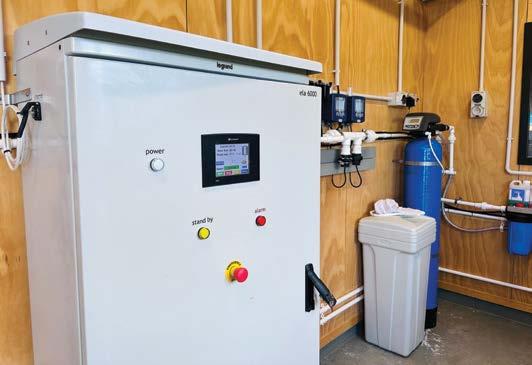
ANK Neutral Anolyte is so effective at pathogen control that pathogens are unable to build up resistance to it, and even at low concentrations ANK Neutral Anolyte will prevent biofilm and algal slime from developing.
ANK Neutral Anolyte is MPI approved, AsureQuality assessed, BioGro certified organic and biodegradable in concentrated form and is not classed as dangerous goods. This is great news for health and safety practices as it requires no special handling, transportation, storage or disposal, providing a safer working environment for staff.
Applications for Envirolyte® technology and ANK Neutral Anolyte within food safety areas are seemingly endless, and together with AWS Group’s ability to create tailormade solutions for their customers’ unique requirements including identification, formulation and delivery, means meeting growing demands for improved environmentally friendly production practices is just a call away.

For more information visit www.awsgroup.co.nz or email info@awsgroup.co.nz
After 12 years of representing the Landini and McCormick brands in New Zealand, Bay of Plenty based AGTEK and the manufacturer of these two brands, Argo, have mutually decided to wind up their long-standing agreement.
Managing director Gayne Carroll comments “it’s been a long journey spanning nearly 30 years from when I led the introduction of the Landini brand to New Zealand at Motor Holdings, then established the brand countrywide at Power Farming, before finally going it alone by creating and building AGTEK into a nationwide distributor, based at Te Puke in the Bay of Plenty.”
Over the last 12 years, AGTEK and its dealers have worked hard to make the Landini name the ‘go to’ brand in the horticultural sector, where it held an enviable reputation for no nonsense operation and productivity. Unfortunately, since Covid-19, the two Argo brands have battled to remain price competitive for New Zealand farmers due to rising global inflation and shipping costs, leading to the difficult decision to end the agreement.
Over the last 12 years, AGTEK and its dealers have worked hard to make the Landini name the ‘go to’ brand in the horticultural sector
Gayne Carroll says, “I understand that a new distributor has recently been appointed, who will initially focus on the Landini brand, with the McCormick product ‘shelved’ at this stage. We wish to thank our loyal Landini and McCormick customers for their support over the years and can assure them we will continue to look after their parts needs going forward.”
“At the same time, we’d also like to say a sincere thank you to the independent, locally owned dealers who have supported us over the years, genuinely believing that these family-owned and local dealerships bring more to New Zealand’s rural communities than their corporate counterparts,” says Gayne.
WE WILL CONTINUE TO LOOK AFTER YOUR PART NEEDS
A SINCERE THANK YOU TO THE INDEPENDENT, LOCALLY OWNED DEALERS FOR THEIR SUPPORT
LOOK OUT FOR UPCOMING ANNOUNCEMENTS ON BRANDS SUCH AS GOLDONI, TYM AND ORIZZONTI
Looking forwards, as one journey ends for AGTEK, another is about to begin, with Gayne and the team currently working on some behind-the-scenes developments that will emerge over the coming weeks and months, to further strengthen and complement the portfolio of brands such as Goldoni, TYM and Orizzonti they currently represent.
For more information visit www.agtek.co.nz



Gordon McPhail : LeaderBrand general manager farming


LeaderBrand’s mega covered cropping operation in Makauri on the Poverty Bay Flats is nearing its first full year of production. The greenhouse is ramping up production of delicate crops like spinach and wild rocket, bringing large-scale
“The greenhouse is set up to be self-sufficient for water, and by all accounts it looks like it will be, but we haven’t put it to the full test yet. Partly because we have seen some summer rainfall and partly because we’re not up to full production yet. The house’s roof is an area just over 10ha. It’s designed to capture 100 percent of the rainfall (with the exception of excessive events where the gutter system overflows in a controlled manner) through a positive head pressure system of underground piping back to our on-site dam. The dam holds 40 million litres and is designed to cater for the current house and a second stage still to be completed in the future. In full production crops in these two stages would consume just over 500,000 litres of water per day.”
“One thing that caught us out is overflow in heavy rains. The gutter system is designed for standard capacity flows or rainfall in the vicinity of 30mm per hour. So when there’s a big rain event, understanding how to manage overflow has been something we’ve been working on getting right. (In a moderate rain of 5mm an hour, the current roof could catch 500,000 litres an hour.) Given how sensitive our crops are to moisture, without rainfall (which is extremely even in its distribution) we have to be extremely accurate in our irrigation volume
consistency in an increasingly volatile climate. NZGrower asked Gordon McPhail how the facility has handled its water demands through the post-cyclone months of ongoing rainfall and this summer’s dry spells.
and distribution, this has been a key work on. Our irrigation system and in particular the sprinklers require a lot of maintenance. We have a lot of flexibility in the overhead irrigation system and can water each bay individually and down to the millimetre. We’re using a Ridder control system, which can be automated based on heat, temperature or light parameters or manually controlled from our phones or desktop. This is a large and advanced system, but it’s all technology that is widely used in New Zealand. It’s hugely important to us that it’s backed up locally, it’s crucial for service.”
“This is our first dam built to provide water irrigation. It’s been a way for us to evaluate storage for additional water security for our business. Water security is a crucial risk for us to manage both volume and quality. This allows us full control of both. Our two main water sources here in the region are surface water from the river and gravel aquifers, which is high quality freshwater but contains a lot of minerals. And the surface water obviously needs treatment for pathogens. Water quality is hugely important to us. The dam is connected to other water sources should we require a top up, and vice versa the dam water storage can back into our system. The dam is fully lined so that reduces the leaching or contamination risk. We run it through a sand media filter and then UV treatment to at least three times the potable water standard.”






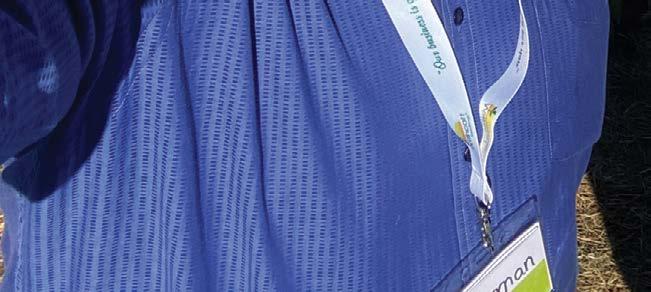





Enza Zaden New Zealand invites you to view our assortment of leafy vegetables at the Lockyer Valley Growers Inc, Vegetable Field Days on 14 & 15 June, in Gatton, Brisbane. Our newest and greatest leafy varieties will all be on display for tasting in person or viewing remotely via Teams.
Contact Herman or Aneil to make an appointment to view our assortment during the field days.
www.enzazaden.com
email: sales@enzazaden.co.nz
